April 15, 2017 / wanderinglightning / 0 Comments
Such a very small world is familiar, and so much of the map is foreign, personally uncharted – especially when you grow up on a farm in 1970’s Iowa. I remember, as a child, my coloring book with a very simple, colorful picture of a farm on the cover – classic red barn, cyan blue sky, kelly green leaves of a tree, and – orange-brown dirt? I couldn’t understand how such a gaffe would be allowed to pass unedited through whatever publishing process coloring books pass through. Because, as everyone knew, dirt was black. Pitch black. Black as the night of a new moon. Black as the void. The void from which all life springs, all colors grow. Black is the source, the secrets of seeds revealed only there, under it’s protective sheltering wing of soil.
It wasn’t until we moved to Colorado when I was a teenager that I saw farms with coloring book fields. Sun-bleached wheat grew from the water-parched orange-brown rows. I marveled that anything could grow without the rich blackness. I watched the distant blue horizon dream hazy clouds into the reality of blue mountain ranges. I was staggered that this fascinating, foreign land lay only one day’s drive from the 300 acres of the familiar.
The wildlife was similar, but changed, bigger. White-tailed deer were supplanted by larger mule deer, and even larger elk. Fewer foxes, more coyote. I saw my first jackrabbits, so much bolder than the tiny cottontails I knew. And, I saw my first ravens.
I had grown up with crows – gathering in the tops of our elm and maple trees, cawing incessantly, rising as one from the harvested corn fields. I had no stories for crows except as garden and field pests, or nibblers of roadkill skunk and raccoon. Noisy as bluejays and less beautiful to see, I had no love of common crows.
But ravens – ravens startled me with their unexpectedly impressive presence. The first time I saw a raven, I knew it was not a crow. I knew from its size, I knew from its face, and I knew from its voice. While I had expected elk to be more than I had imagined, more majestic than deer, awesome and thrilling as they slowly stepped between tall pines in the high forests…well, I hadn’t thought about ravens being in Colorado. Edgar Allen Poe wasn’t from Colorado, and he was my only reading on ravens. I had no frame of reference. And since I had no frame of reference, I was wide open to my experience. So seeing my first raven surprised me, and expanded my mind. Because it was more than I knew. It was beyond my familiar.
I have since found out that this is the mythology of the raven. Smart and strong, Raven is a character of metamorphosis. To the Hopi, Navajo, and Zuni of the Southwest, Raven has trickster energy, a bearer of magic and messages from beyond time. Raven flew out of the great darkness carrying the stolen sun and so brought the light, transforming the world. In Norse myths, Odin had two ravens named Thought and Memory who flew over the earth and brought information back to him. Like Aquarius of the zodiac, Raven shares knowledge that comes from elsewhere, that pours like water and illuminates like lightning in the night.
I hadn’t seen a raven in years. But the birth of my second grandbaby brought a fortuitous mistake of too many helpers converging on my daughter’s home on the same weekend. What to do? In Gallup, New Mexico? The answer came to me immediately: take off for the Grand Canyon, of course. I had never been, and it was only a few hours away.
We helpers were like crows, grandparents and aunts and uncles gathering, cawing and restlessly ruffling our feathers as we spied for tasks like dishes and laundry and taking out the trash. We feasted on the sweetness of mama and baby and tiniest big brother on the couch together, then rose like a heavy wave of family helpfulness into the rooms of their home. At times we sat quiet and watchful, contentedly perched together, roosting. But crows know the cultivated fields, and soon we’d be back in the kitchen, cawing out questions of favorite meals and freezer space and Tupperware.
I was sad to go. But as soon as I was headed for the Grand Canyon, I let it go, easily. New Mexico softens its vistas with sage hills and low mesas and rounded mountains; but Arizona is wide, wide open, pushing your vision to the horizon and then up into the endless sky. I flew along in my jeep, rambling through the Painted Desert, discovering forests petrified into jasper and crystal before humans had written words, their hopes and fears and baby’s handprints carved into red stone.
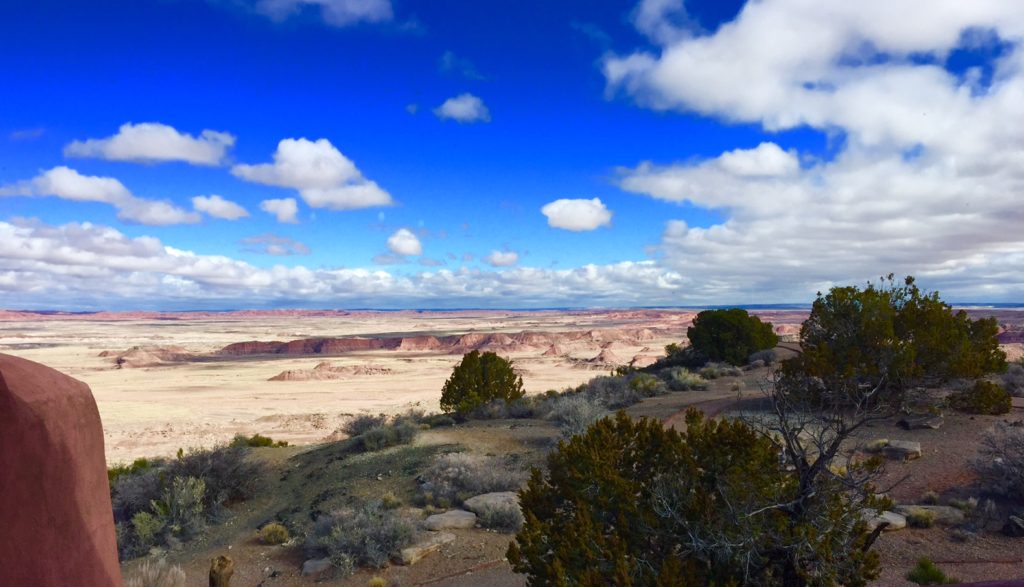
I passed Fort Courage, wasted bottomland filled with old trailers covered in painted aluminum, vinyl siding, plywood, and treaties. Old pickups bleached like bones in this desert sat parked on mismatched tires, tread, no tread, bald like bald-faced lies, American flag snapping in the wind over a yellow dog trotting in dust.
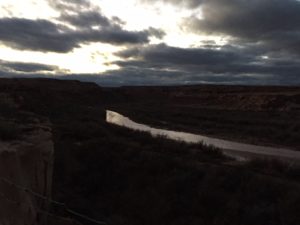 I got a room at the Cameron Trading Post, circa 1916, where you can still walk into the deep Southwest, buy a bag of Bluebird flour, some jerky, coffee, and a blanket woven by an Indian, sold by an Indian. The trading post still holds the south bank of the Little Colorado River, and I watched it wind its muddy way west under the deepening sky to join the canyon I would see tomorrow.
I got a room at the Cameron Trading Post, circa 1916, where you can still walk into the deep Southwest, buy a bag of Bluebird flour, some jerky, coffee, and a blanket woven by an Indian, sold by an Indian. The trading post still holds the south bank of the Little Colorado River, and I watched it wind its muddy way west under the deepening sky to join the canyon I would see tomorrow.
I woke in the darkness, black sky sharing the tiniest stars like secrets over an unseen desert. I drove up scrubby foothills where, at the top, elk and deer wander through pine forests standing in dark pools of melted snow, cold February evergreen swamps on mesas of rocky clay and limestone that cannot soak it all in, and neither can I.
When I rose over a hill and saw my first pre-dawn view of the Grand Canyon, I laughed out loud, goofy raw croaks of surprise, delight, and recognition of something beyond time, all vying to be expressed first, immediately, forever. I parked at the overlook and walked out to the edge to watch the sun rise. A few other people stood nearby, facing east, waiting for the sun. I faced west – waiting for the effect of the sun on the vast canyon itself. As I stood alone, sensing the shifting light before dawn, I had the most unexpected feeling: contentment. I felt as open and quiet as the distances before me, while I stood in the chill morning breeze and watched pink tinge the clouds and then the highest ridges of stone, followed by golden orange, and finally the yellow light of sunrise. Silently, two ravens rose with the sun, up from the darkness of the cliffs and canyons below, their feathers like fingers lifting the light into the sky.
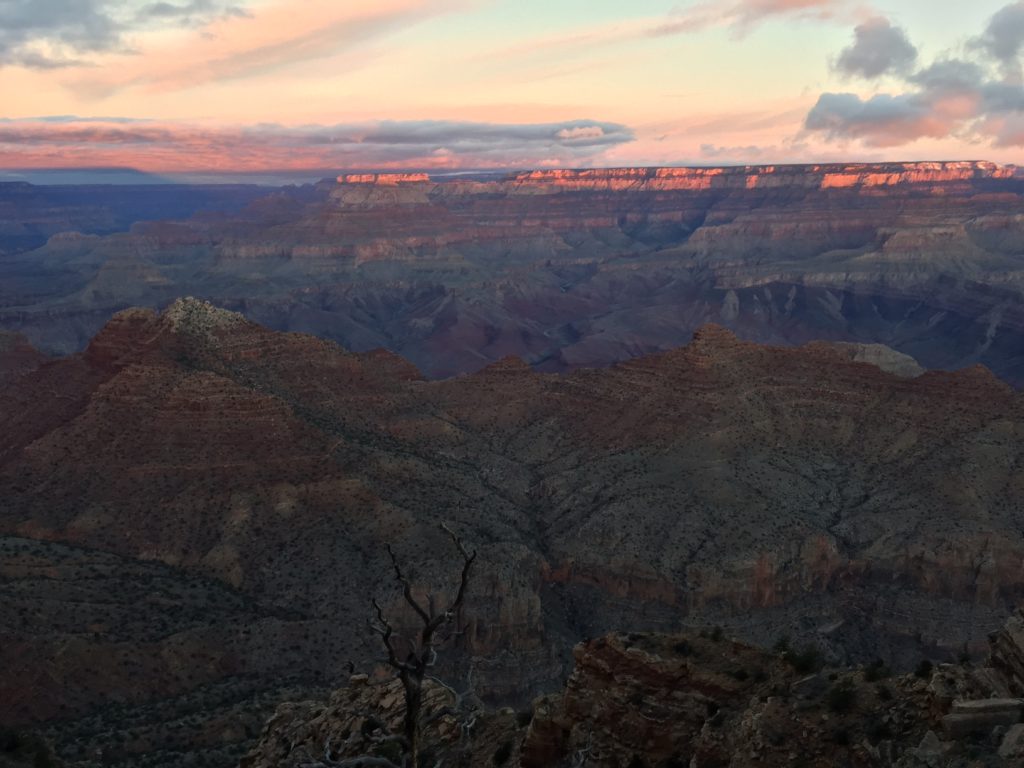
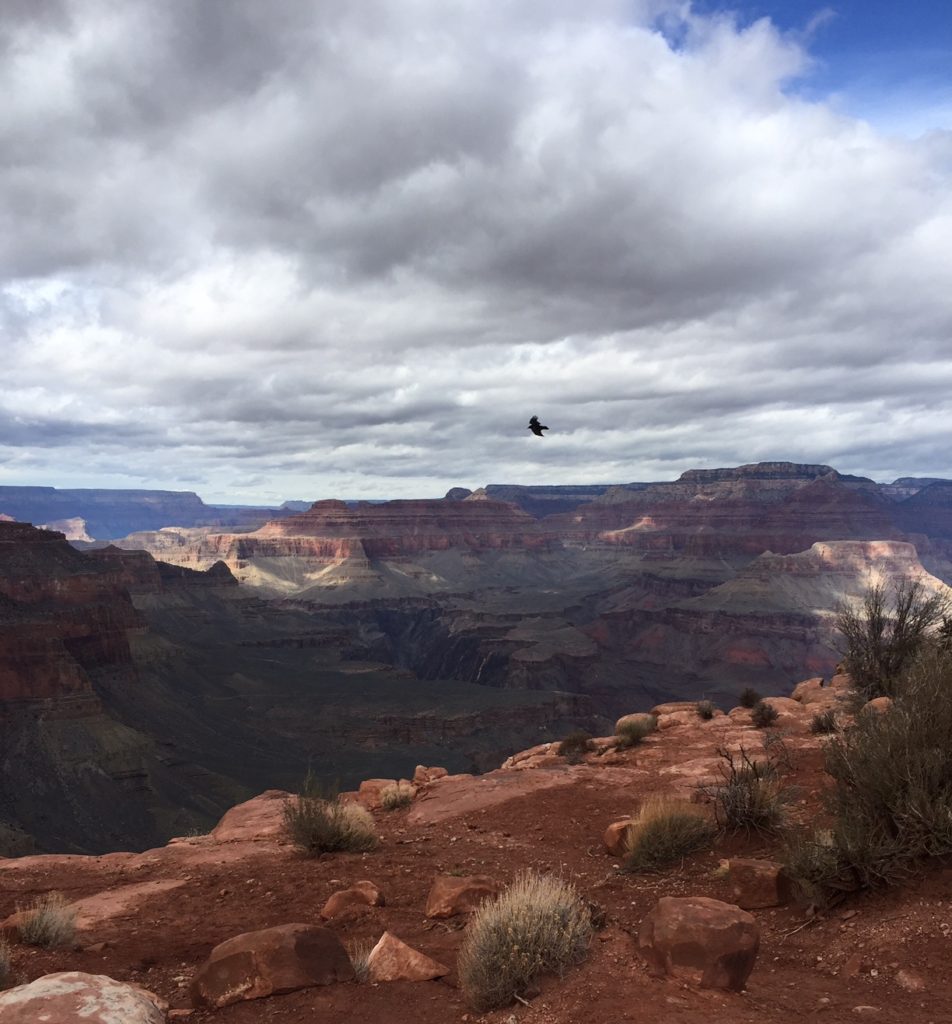
The sun danced with clouds through the whole day, light and shadow, warm in the sun, chilly in shade. I hiked down into the earth for hours, following long thin paths along the yellow, orange and magenta rock walls, colored like the sunrise. As I stopped for water and rest, always the ravens circled by twos, circling each other before lifting or drifting to the next island of earth in this ocean of air and time.
As evening approached, the clouds thickened, rolling over the immensity of the canyon. The sun set behind heavy rains rolling across the great depths, across the blackness of the void. The source. The blackness from which all light and life came, safe under the protective, sheltering wing of that now-familiar trickster, Raven. I stood in the rain, in the dark, on the edge of the Grand Canyon, in a space circled by thought and memory.
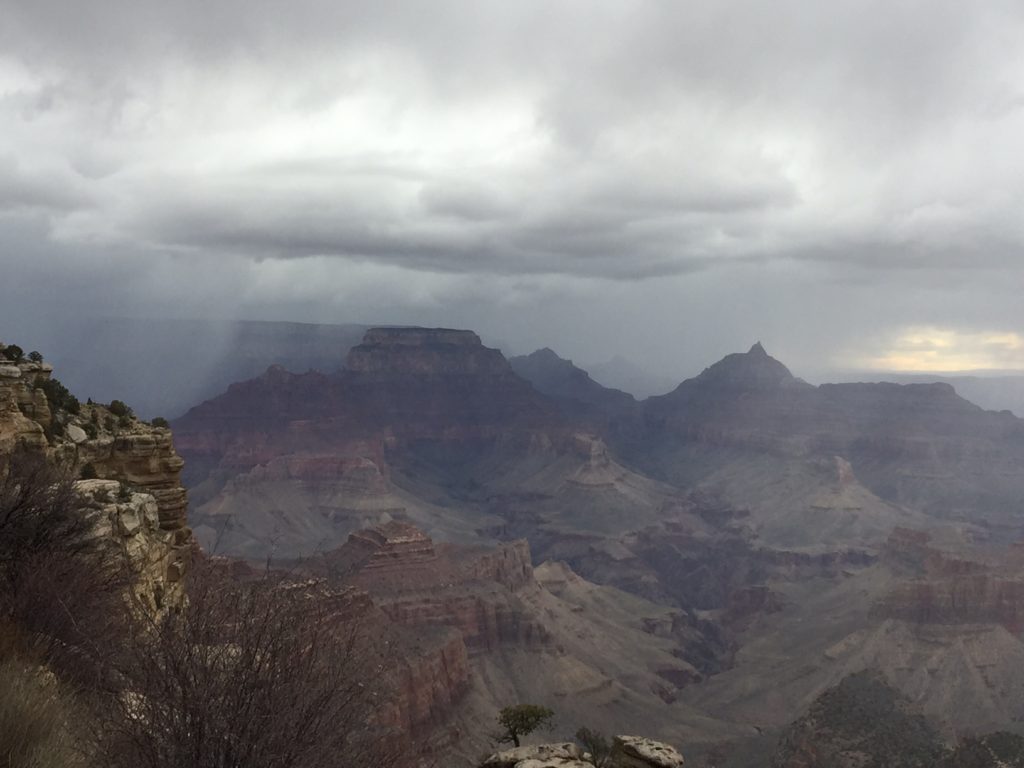
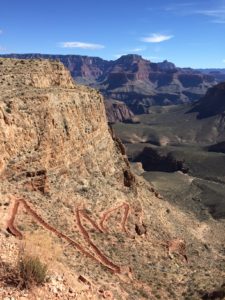 red mud trail
red mud trail
sliding down switchbacks
into depths
I have yet to know
this clay and sand
this earth and snow
today the ground
beneath my feet
is liquid pooling
every step
will suck me down
to the old world beneath
through the hole in the sky
at the bottom of the canyon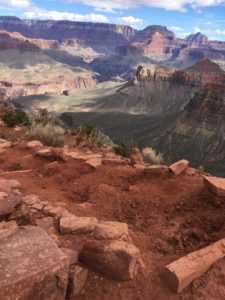
compelled to reach
my hands in
to this earth’s lifeblood
stain me red
and so it does
ochre of birth and death
across so many ages
my palms
now touch the sacred walls
of life
and from my fingers
forms a dripping tiny bird
its wings will dry
and I will fly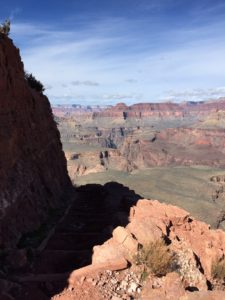
my path these smoothly worn
and muddy stones
that wind and rise
the edge
along this
vast
unending
precipice
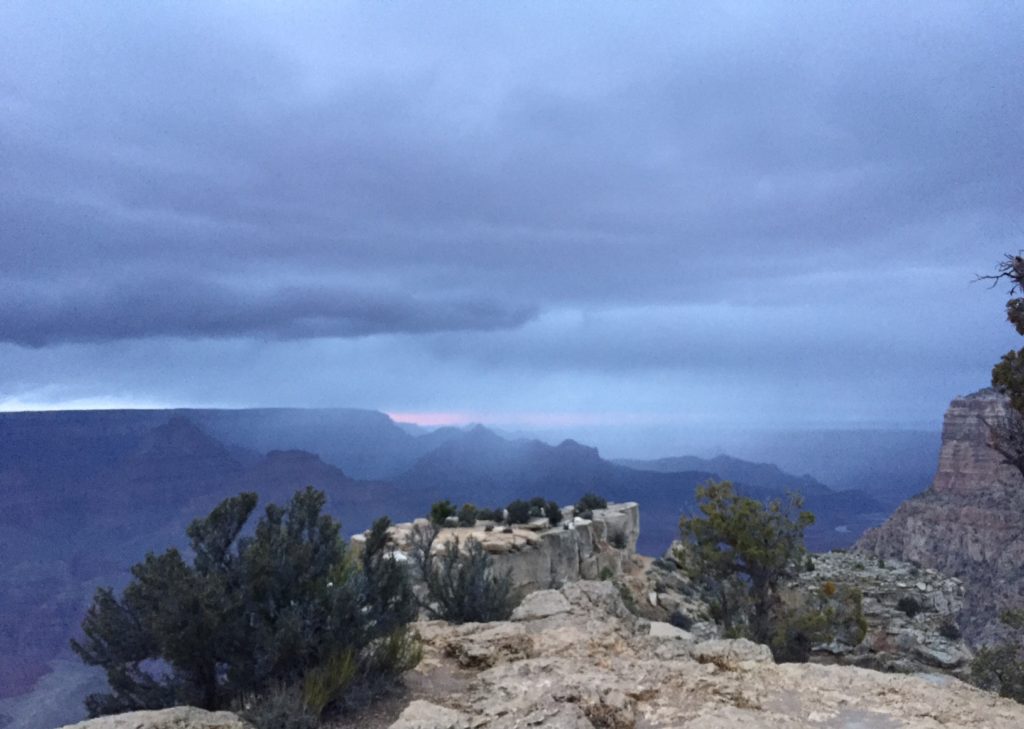
January 29, 2017 / wanderinglightning / 0 Comments
Roughly 150 demonstrators greeted travelers Sunday afternoon as they emerged onto the Westin Plaza at Denver International Airport. Holding signs reading, “Diversity is our Strength” and “We the People welcome you,” protesters chanted, “No hate, no fear, refugees are welcome here.”
As multiple federal courts issued orders to temporarily stay the president’s executive order banning all refugees, as well as citizens from seven Muslim-majority nations, from entering the U.S., immigration attorneys have been mobilizing to gain access to travelers who may be detained currently in our nation’s international airports. Local members of the American Immigration Lawyers Association responded to alerts from the International Refugee Assistance Project. According to Denver attorney Christina Brown, approximately 20 immigration lawyers were at DIA on Saturday; on Sunday, more lawyers arrived as word spread through Facebook and email groups.
One of Sunday’s arrivals was Jennaweh Hondrogiannis, a private immigration law attorney. When asked about coming to DIA on the weekend, Hondrogiannis responded, “This is the work we do. When we’re needed, we’re here.”
Laura Lunn, a managing attorney with Rocky Mountain Immigrant Advocacy Network, and private attorney Kristin Knudson volunteered with the newly-formed DIA Pro Bono Legal Project. They explained the difficulty with helping immigrants and refugees to access their rights under the current executive order. People wanting to enter the U.S. “who assert a credible fear or a reasonable fear have a right to be interviewed,” noted Lunn, referring to a credible fear of persecution or torture if the person were to return to their home country or country of last residence. According to Knudson, the “credible fear interview” is to determine if the person may be eligible for asylum. These interviews are conducted by asylum officers of USCIS, known commonly as Immigration Services. Immigrants have a right to legal representation when seeking asylum.
Lunn explained that the current executive order is focusing on the “expedited removal process” for immigrants, which immediately returns people with “no expressed fear” to their country of origin. The problem, according to Knudson, is that refugees without legal “refugee” status often don’t know they have a right to speak up about the dangers that caused them to leave home. Lunn stated, “They don’t know the magic words that could open the doors.” U.S. Customs and Border Protection officers (CBP) of the Department of Homeland Security are supposed to directly ask immigrants why they left their home country and if they have fear or concern that they would be harmed if they returned home. At issue is the lack of access to legal counsel within this process, as immigrants are interviewed without having an attorney present, and may feel unsafe or unsure about what to say. People with legal “refugee” status have already been deemed unsafe to return to their home countries and determined eligible to enter the U.S. But now their entry is being blocked.
The attorneys at DIA said they have no way to know if the appropriate questions are being asked. Ordinarily, immigration attorneys call in to CBP to advise officers that they are on-site and wish to see their detainee clients. Now, no one at CBP seems to be answering their phone calls.
In addition, U.S. residents have been caught up in the expedited removal process. Citizen advocate Marcela Mendoza spoke up among the attorneys lined up in front of the International Arrivals gate at DIA. “The executive order is so overreaching – it included people with green cards,” she said, meaning people with lawful permanent resident status. “That’s why the ACLU filed a writ of habeas corpus in New York – but Homeland Security won’t follow it.” That court petition for writ of habeas corpus is Darweesh v. Trump, and includes the following statements:
“After conducting standard procedures of administrative processing and security checks, the federal government has deemed both Petitioners not to pose threats to the United States. Despite these findings and Petitioners’ valid entry documents, U.S. Customs and Border Protection (“CBP”) blocked both Petitioners from exiting JFK Airport and detained Petitioners therein. No magistrate has determined that there is sufficient justification for the continued detention of either Petitioner. Instead, CBP is holding Petitioners at JFK Airport solely pursuant to an executive order issued on January 27, 2017.”
A young black woman, Z., sat holding a sign for the DIA Pro Bono Legal Project, the name of this ad hoc congregation of Denver attorneys. She wore a nametag labeled, “Legal Monitor,” as all the volunteers with the project did. When asked why she had volunteered, Z. replied, “I am refugee. When I hear this, I feel bad.” She has been in Denver a little over six months. “Refugees – most of them are starving, most of my family are there. Maybe when they come here, they find peace.” “There” is Congo in east Africa; Z. said she left to escape war. She said the African Community Center in Denver helped her get her local identification documents when she “came with legal papers,” and also helped her find housing in Aurora.
She is still haunted by her journey, though. “Father not come – day of departure, his visa still not arrive, so we leave without him.” She and her sisters were 19 and older, so they were allowed to go. “Mother, we lost her, in the war. We don’t know if she alive or die. Lost her. Lost.” Z. tears up but maintains her composure. “Refugee story is bigger – is bigger story.” She smiled again, and turned with her sign. “I can’t fight against government. Our neighbors, Sudanese, they are starving. If I have possibility, I can make the peace.” She paused, then added, “I am Muslim.”
Behind her, attorneys shared updates. “Do we have a name?” “We have a birthdate.” Christina Brown noted, “No word yet, though.” Lunn added, “CBP won’t talk to us, won’t take our calls in there. We spoke to colleagues in D.C. – this is happening at all the airports.”
January 29, 2017 / wanderinglightning / 0 Comments
I parked in the REI parking lot, and walked toward the faux-chalet entrance mulling the pros and cons of water tablets versus water filtration for my next long backpacking trip.
Ahead of me, a very tall, very big, older white man walked toward the store, decked out in shiny, new hiking wear and the aviator sunglasses beloved by men of a certain age. He was imposing; I’m pretty sure he knew that.
He opened the door, and held it open for me. But I was putting my phone away in my pocket, so I said, “That’s okay – you first.”
He looked down at me and said, “After you.”
I stopped, squinted a bit and said, “No thanks, go ahead.”
He paused, almost smiling in that near-sneer some men do, looking down at me through those mirrored aviators, and said calmly, “After you.” He had not moved a muscle.
I got that angry chill up my spine and neck. I looked him full in the face and said, “No thank you.”
He did the doorman arm gesture of slowing ushering me inside, and pronounced, “After – you.”
“No – thank – you.”
We stood, in the entryway of REI, locked toe to toe and eye to eye. Well, eye to mirrored aviators. Neither of us had raised our voices. Neither of us had taken a step. But he just could not stop. He actually said it again.
“After you.” It felt menacing. It sounded icy cold. It reeked of control and power.
So I took a deep breath, cocked my head, and said, “I can stand here all day, friend.” The smile twitched in the corner of his mouth, but then an REI employee approached. The big man turned and went inside. As I opened the door, the employee was saying to him, “Standoff in the doorway, huh?” and glanced at me with surprised eyes. Not exactly nervous eyes. Or worried. Or even concerned. Possibly, just possibly…slightly embarrassed. But you can never quite tell. It’s hard to read someone’s eyes.
Especially behind mirrors.
Such chivalry afforded to the weaker sex today. Heartwarming.
Here’s a tip, for all the confused authoritarian patriarchs out there wondering what’s gotten into the little women lately: we see you. You’re a sham. Smoke and mirrors. Fakes. Frauds. Your spinelessness shows in your bullying of people smaller, poorer, less empowered in the world you strut through.
We are the authorities on our own existence. We decide about ourselves – about our bodies, about our rights, about our options.
About which doors we will go through, and which doors we will not. We have the power to open our own doors, for ourselves, like other men you do not hold doors for, gritting your teeth to say, “after you” to them. We are your equals. And our eyes are wide open to how we have to stand up for that fact. In the most ridiculous places, in the most tedious ways.
Chivalry can die; the King is dead. Long live actual Equality instead.
January 22, 2017 / wanderinglightning / 0 Comments

“Tell me what democracy looks like — THIS IS WHAT DEMOCRACY LOOKS LIKE! Tell me what democracy looks like — THIS IS WHAT DEMOCRACY LOOKS LIKE!”
“Tel
Louisa May Alcott took to the streets for women’s rights in the 1870’s, going door-to-door in Concord, Massachusetts, to secure the right to vote. She was with us again in spirit yesterday, January 21, 2017 – all over the world, to secure the right — to Be.
I read Little Women as a girl in 1970’s Iowa, identifying with tomboy Jo, who was of course Louisa herself. Louisa had younger sisters, as I did; an older sister, and I had several. She not only admired the writings of Henry David Thoreau, as I did, she knew the man himself, and spent time at Walden Pond learning botany and most certainly ideas about civil disobedience, as well.
I like to help women help themselves, as that is, in my opinion, the best way to settle the woman question. Whatever we can do and do well we have a right to, and I don’t think any one will deny us. — Louisa May Alcott
Oh, but deny us they do. With the election of Donald Trump, “the woman question,” which we thought to settle with the election of Hilary Clinton, became an open wound of outrage and despair as a self-confessed sexual predator placed his tiny, “pussy-grabbing” hand on an actual bible and swore to “preserve, protect, and defend the Constitution of the United States.” The flesh-and-blood citizens of the United States, well, good luck to you. And me.
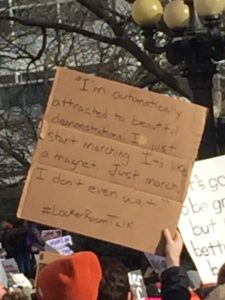
You have a good many little gifts and virtues, but there is no need of parading them, for conceit spoils the finest genius. There is not much danger that real talent or goodness will be overlooked long, and the great charm of all power is modesty.
See, the thing is, Louisa, we are pretty concerned that there is in fact a clear and present danger of all our talents and goodness being not only overlooked but attacked, systematically, since Conceit took office. So when my youngest sister asked if I wanted to go to the Women’s March on Denver, I said yes immediately.
I don’t do protests. I write what I want, and say what I feel, which is how I have justified the fact that I don’t do protests. All my life, I have seen protest marches as naive and smugly self-serving, an act of conspicuous righteousness that later falls away into a return to the status quo. The truth: I am cynical that walking a parade route will change anything. But this year, it is different. This year, the certainty of oppression and abuse is undeniable. And I have daughters now.
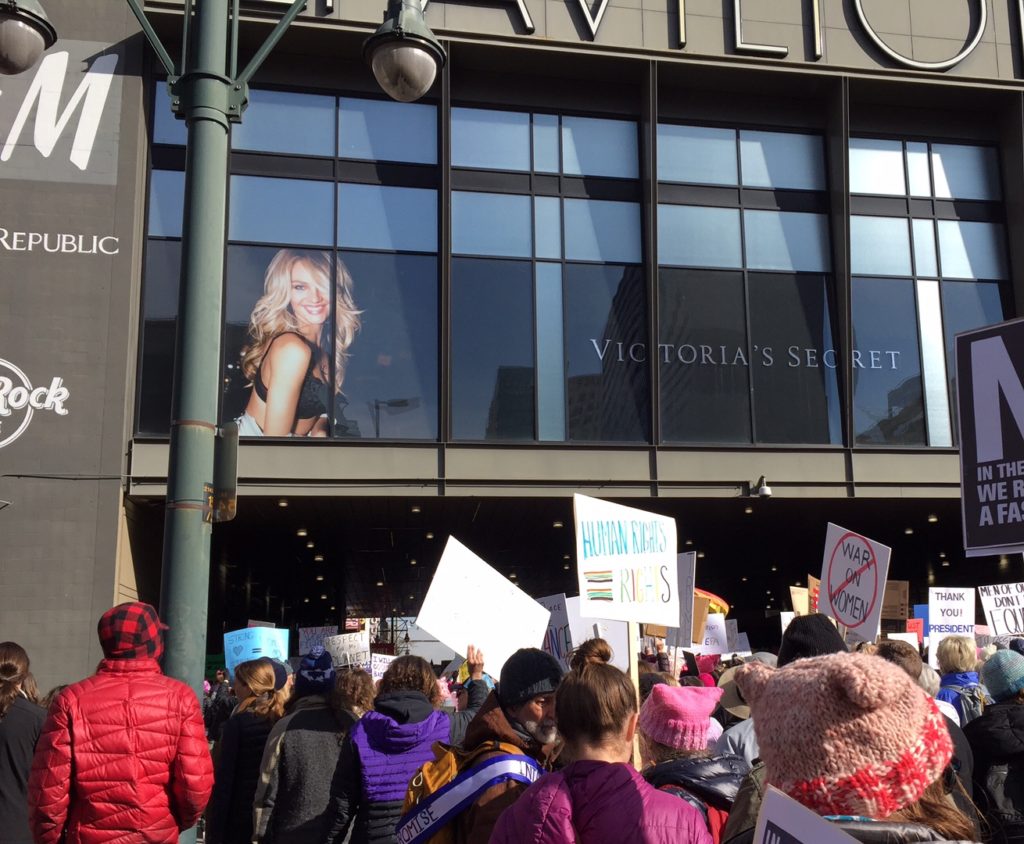
Women have been called queens for a long time, but the kingdom given them isn’t worth ruling.
Oh, Louisa, my girls are indeed fabulous. Not in terms of fashion and hair and pageant-worthiness, though they are spectacularly beautiful to see and hear. We three together scoff and laugh at being judged in Conceit’s shallow terms of women. My girls are true women. They scale rock faces and mountains and travel between continents and love Gloria Steinem and leap into the unknown waters of their lives from the high cliffs of my arms. I cannot stop them. I would not stop them.
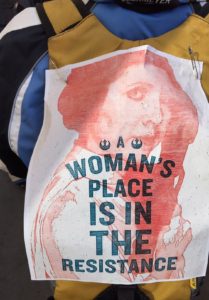
Love is a great beautifier.
One daughter is ferociously following her career, stalking it like a hunter. Because she can read tracks of possibility and smell opportunity on the wind, she finds the hidden work that can feed her soul. She has a quiet center to hold herself firm out in the wild. She went to the Women’s March in Washington – on her own. At 23. From Boston.
And one is a mother, one child running full-tilt into each day, one swimming in the deep waters within her, soon to arrive. She speaks many languages – English, Spanish, and also Compassion, Poverty, Art, Confidence, Encouragement, Strength. A woman of the high desert, she communicates with rock and stone, tender green and yellow flower, warm fire and stars at night. With all people. But the new baby is too close, and the 2-year-old too fast and fearless, for her to come to the March in Denver.
Far away there in the sunshine are my highest aspirations. I may not reach them, but I can look up and see their beauty, believe in them, and try to follow where they lead.
They are my sun and moon, these two women of my heart, guiding me by day and night. And everything they represent is in danger.
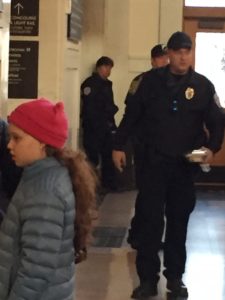
Painful as it may be, a significant emotional event can be the catalyst for choosing a direction that serves us – and those around us – more effectively. Look for the learning.
So I met my sister at Union Station, a fitting name. And we and her friend joined 100,000 new friends at Civic Center Park, another fitting name, and wrote our dreams like nametags on scraps of paper we tied together into prayer flags for us all – old, young, queer, straight, trans, sis, black brown red white yellow purple green, a pink-hatted rainbow of human beings with the sharp ears of cats, hopes fluttering and dancing and stomping their feet to warm their toes on a chilly Saturday morning along the Rockies.
I heard a woman say to the teens walking by with her, “You’re making history.”
And that is when I really saw them – the little women. Girls, everywhere, such thin little arms and legs, long forming faces and chubby cheeks, signs in their hands, signs hung by their legs, signs in front and behind them. I wanted to read their words, hear their words. So I just started asking.
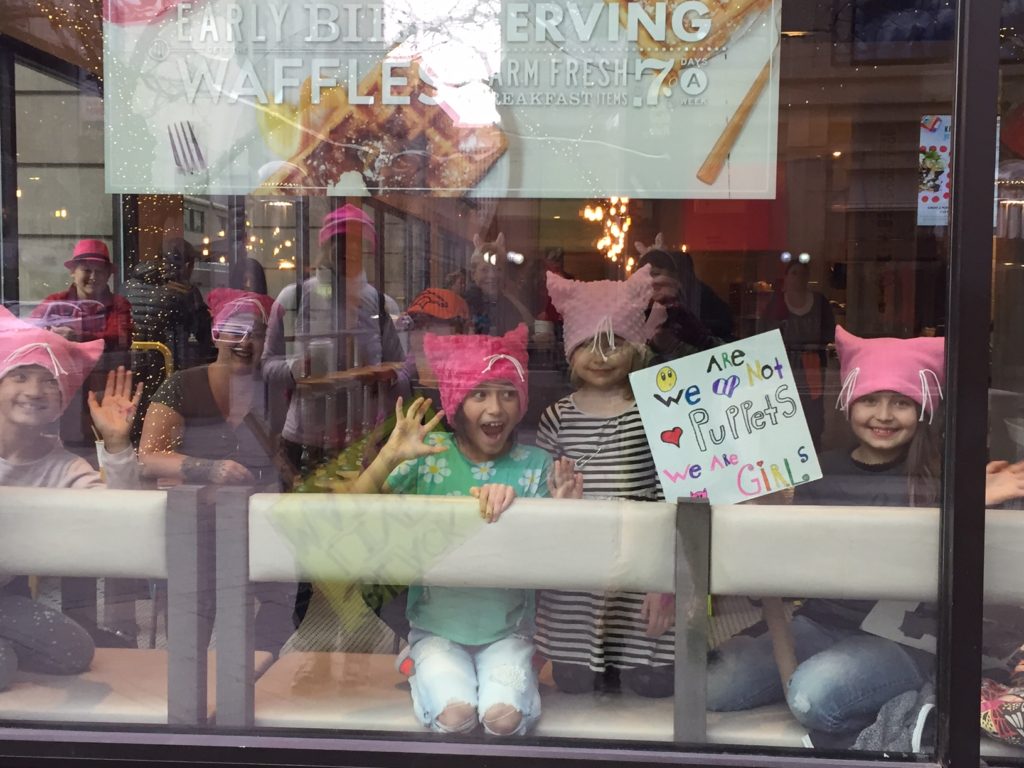
“Hi, can I see your sign? What do you think of all this?”
“Really cool – that people are standing up for our country.”
“What would you tell President Trump if you could?”
“I don’t know….”
“What’s on your sign?”
“Respect.”
“Would you tell him that? Who should he respect?”
“Us. Everybody. Women.” — Talulah, 11
And so I sought them out. So many little women, apprehensive or bold, verbose or shy. Holding signs of power and dignity.
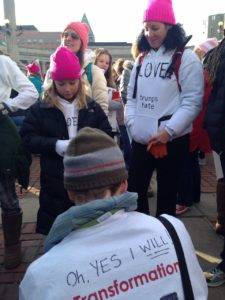
“I’m here cuz Trump sucks. I would tell him, ‘You suck – be nice to people.'” — Carmen, 9
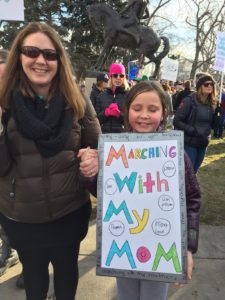
“The things you say aren’t right. You should be more fair.” — Amelia, 9

“I’m here to fight for our rights. I don’t think he’s a very good president. I would tell him, ‘Respect people’s rights and keep the Affordable Care Act and other things people depend on.'” — Lucia, 12 “Respect people’s health care.” — Maggie, 10

“‘Treat people the way you would want to be treated’ – does he? Not everyone.” — Sofia, 11 “I’m here to protest for our rights – our ability to have our voice heard. I would say, ‘Everyone should be equal. Treat everyone the same.'” — Clara, 11
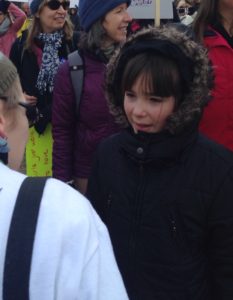
“He should treat everybody the same.” — Mia, 9
And then, just before we finally marched, something opened up. The boys started talking to me.


A sweet boy emerged from among the girls. “I’m here to march with my mother. I think some things are gonna change. I don’t really know which, but I know something’s gonna change.” — Wilder, 11
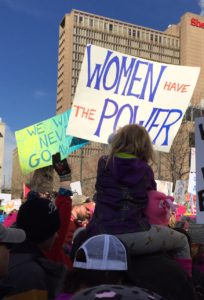
A tall, skinny teen laughed and smiled with his little sister, who was on their father’s shoulders. I pointed to him and said, “We’re glad you’re here.” Women behind me repeated the sentiment. He beamed and said, “I wanted to be here.”
Two young, beautiful men, a mixed-race gay couple, held hands as they marched. “We didn’t bring a sign, so this is our sign,” one said, lifting their joined hands. I asked if they were able to do this all the time, any time they wanted. “Well I would, but not him.” They laughed. “It’s getting better. Obviously, here, we can. You pay attention, sometimes you can, sometimes no. But it’s getting better.”

Let my name stand among those who are willing to bear ridicule and reproach for the truth’s sake, and so earn some right to rejoice when the victory is won.
I learned so much yesterday – about my sister’s love of community, about my daughters’ security in themselves, about other mothers’ daughters and their beliefs in respect and inclusivity. And about other mothers’ sons – men, like my own sons, who offer respect as a matter of course. Who believe firmly that things can change, that things get better.
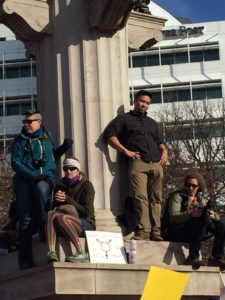
I learned about the power of protest, when we walk together to have “our voice heard” – our voice, like 11-year-old Clara said. Loud, chanting, repeating the words that matter. Many people, one voice. Taking one step together, then another.
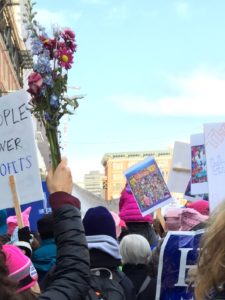
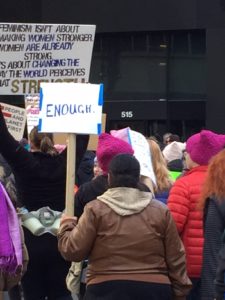
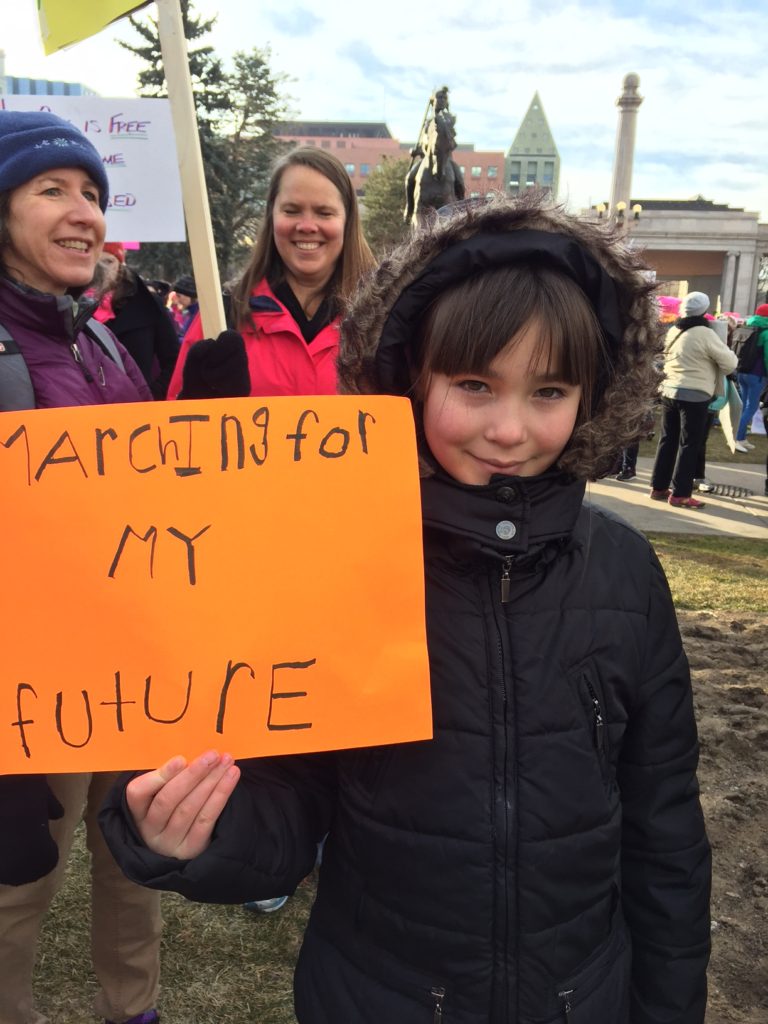
Mia, 9
Thank you to the parents/guardians of these young people for giving permission at the march for photos and interviews. Any proceeds from this article are being donated to N.O.W. (National Organization for Women).
January 22, 2017 / wanderinglightning / 0 Comments
Finally, across the river it appears, languid as a waking cat, a gray panther rippling and slowly rising, turning its head my way. Through the train window, I see New York for the first time.
The music of the train on the tracks beats the rhythm of the city.
I’ve been to every single book I know
to soothe the thoughts that plague me so
stop before you start
be still my beating heart
(be – still – my – beat – ing – heart)
— Sting, Be Still My Beating Heart
I have the giddy excitement of the young artist wrapped in the aging body of the immigrant family patriarch. I think about how my family first came to New York by boat from the icy waters of Sweden and Denmark. My 12-year-old great-grandmother bringing her young girl heart and sweet possessions in a curving trunk with little blue flowers embossed and painted on the tin between arcing wooden ribs. My grandmother born first generation in this country.
I remember a great-great-grandfather who sailed between Denmark and the U.S. multiple times, checking on his sons in America, darning their socks I am told in childhood stories, and cooking with them, these young green men eating the traditional food of their father and his homeland.
My people leave. We go. The descendants of Vikings, we sense a larger world, and make epic voyages to find places of a scale to match our vision. Or so we tell ourselves. We feel confined, is the root cause. Constricted, by small minds and limited opportunities and a blood sense that there is more to us than we have yet seen in ourselves. We chain ourselves with responsibilities, then chafe raw against the shackles. We create home, then leave it behind.
You tell him to come in sit down
but something makes you turn around
The door is open you can’t close your shelter
You try the handle of the road
It opens do not be afraid
It’s you my love, you who are the stranger
It’s you my love, you who are the stranger.
— Leonard Cohen, The Stranger Song
It’s not particularly noble. But it is fierce, and within each generation, we seem to have one who feels it like a burning in the skin, some fire that can only be quenched by returning to the sea, to windswept ice and snow, to mountain peaks – to wild and endless vistas. My grandpa Holger left his farm and young family to see the wide Pacific, breathing with the endless tides. My father left the midwest farm over and over, for the cowboy dream of the West, for the oceans, for the mountains, for a traveler’s life across America.
Where do I put this fire
this bright red feeling
this tiger lily down my throat
it wants to grow to 20 feet tall
I’ve left bethlehem
I feel free
I’ve left the girl I was supposed to be and
someday I’ll be born
— Paula Cole, Tiger
I want to leave America itself – so first, I am returning to the gateway. Where languages swirl from the streets through books I have read and never read and poems yet to be written. New York: oh holy Mecca of poets. To find myself at home among my patron saints, living and gone. So I can go.
We create the gods we kill
then give them
immortality…
— Sting, 50,000
I cannot write one essay that captures my week in New York. I will be sending postcards from New York for the rest of my life, 4×6 illuminated manuscripts of ordinary street life written in holy water from the filthy Hudson and East rivers. As a pilgrim on this spiral poet’s path, walking through Central Park and over the Brooklyn Bridge and down into the subway stations was every bit as sacred as entering a zendo or a cathedral or circling the kaaba, the huge dark squares of this city containing the alien, meteoric soul of word and rhythm and sound, survived from beyond familiar life and atmosphere to arrive burning with the message of endless worlds and endless possibilities.
Step outside
take a step outside …
heart’s on fire
leave it all behind you …
dark as night
let the lightning guide you …
— Jose Gonzalez, Step Out
It has birthed a tiny book, chapbook preemie still in the supportive incubator of layout and typeface, its photos taped like oxygen tubes into its tiny nostrils, reaching and softly kicking the smallest arms and legs of lyric and image. It is growing into it’s strongest self, now, under caring attendance. It is warm, and alive. Like a new generation in this land of immigrants. Like a newly-discovered holy scroll written on crumbling newspaper unearthed beneath a torn-up subway track. I will take it with me; and ultimately, I will stand it on it’s own strength, and I will leave it behind.
October 25, 2016 / wanderinglightning / 0 Comments
The day was fierce, with the leaden skies of early autumn spitting the first snow of the season. The tiniest dry grains of snow hissed over my jacket and across my face as I hitched my pack onto my shoulders. I was standing at a trailhead that was new to me. A sign beside the posted map warned that I was entering mountain lion country.
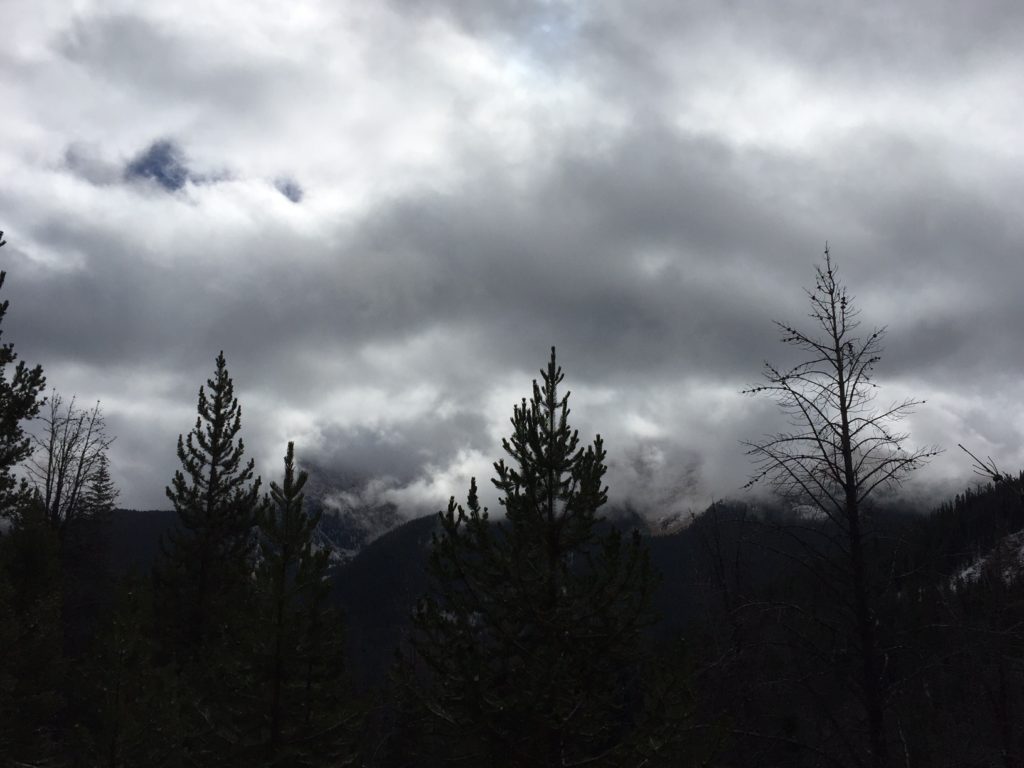
When you walk into the land of lions, you think about the very real possibility of death. As I hiked the early switchbacks through dense forest, I repeatedly imagined and brushed aside countless visions of a huge cat leaping onto my turned back and knocking me to the ground before I’d even heard it coming. The trailhead sign advised a “sturdy walking stick” because “it can be used to ward off a lion.” Conveniently, someone had left two such sticks leaning quite obviously against a pine next to the trail. I typically mock the aluminum hiking poles of tourists and those with unlimited gear budgets, those ski poles for summer that hikers seem to utilize so awkwardly. Yet here I was, grabbing the stouter of the two branches someone had intentionally broken to length and cleaned of twigs. It immediately fit my hand, my height, and since it was old dry wood, was light and easy to swing. This was a hiking stick, not a ski pole. This was a staff, for combat. I twirled it like a baton, as if I was some trained warrior, and then took it with me.
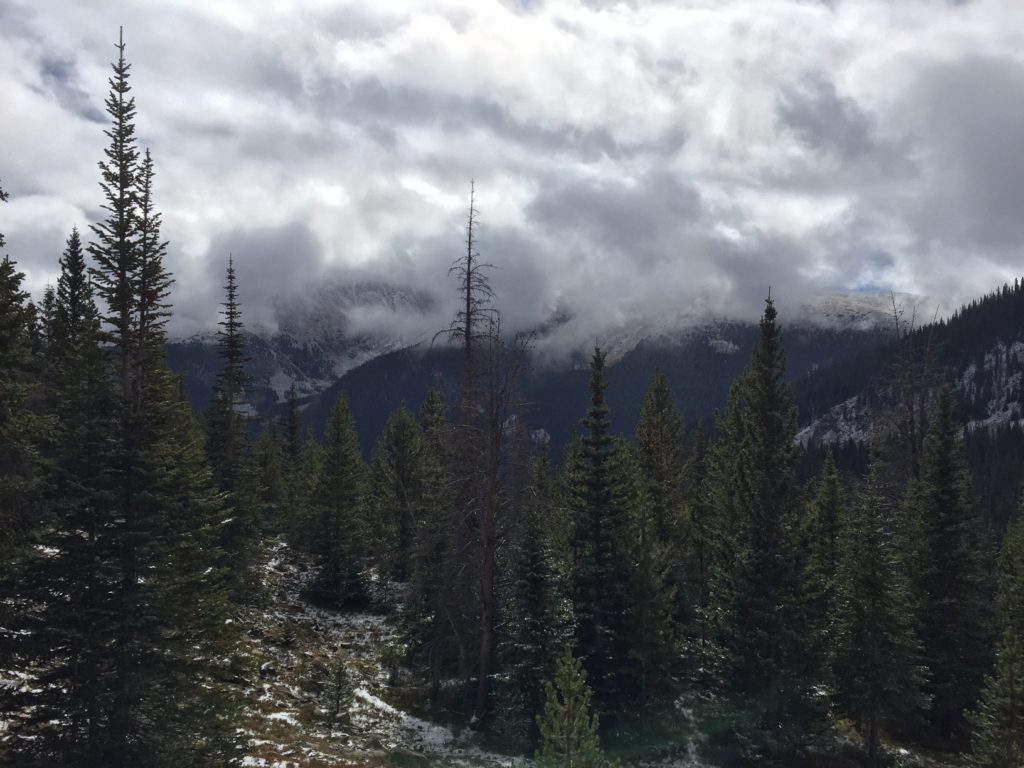
The moments of our life are not expendable, and the possible circumstances of death are beyond imagination. If you do not achieve an undaunted confident security now, what point is there in your being alive, O living creature? ― Padmasambhava, The Tibetan Book of the Dead: First Complete Translation
Huge cloudbanks poured in over one mountain range onto another, peaks obscured in cloud and snow. I hiked on, watchful. The thin air hung heavy as I approached 11,000 feet. Anytime this high in the Rockies, thick cloud and skiffs of snow are nothing to ignore – and it was early October.
I have been hiking in Colorado for 35 years. I know how my boots should feel on my feet, if my pack is balanced, how much food and water to bring, when to add or remove layers so I don’t sweat, I don’t chill. They say “cotton kills” but I’ve always worn it anyway, layered with wool, because cotton doesn’t kill people – apparently, on this trail, mountain lions kill people. Actually, not that often; more often in the mountains, stupidity kills people, recklessness kills people, forgetfulness kills people. Ultimately, it is Time that kills people, and on these gray, wet days, I feel it, in my aging joints aching until I get warmed up and going. Then I ache again once I’m down and done. Ever since I was seriously ill a few years ago, I feel less invincible, knowing my strength may not always be a given any more. The mountains look unforgiving this day in Lion Country, and bring my thoughts to old age, sickness, and death, the all-too-real lions and tigers and bears that we all must face.
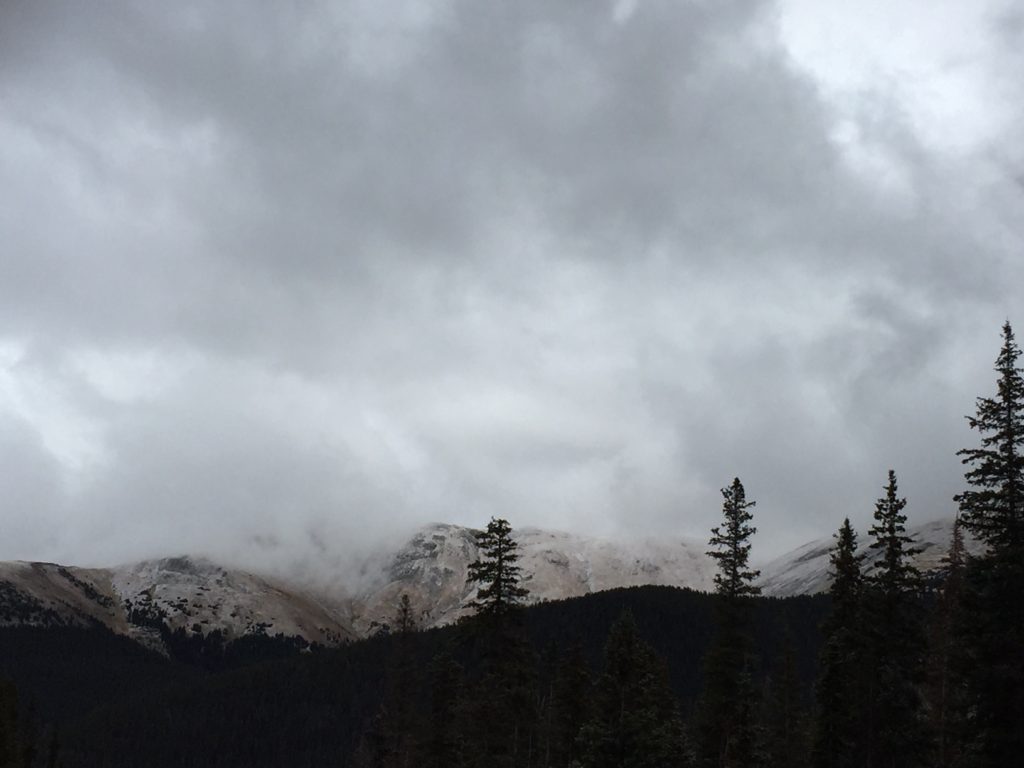
Are you oblivious to the sufferings of birth, old age, sickness and death? There is no guarantee that you will survive, even past this very day! The time has come for you to develop perseverance in your practice. ― Padmasambhava, The Tibetan Book of the Dead: First Complete Translation
I remember taking my kids hiking when they were little. “Can you see me?” I would call to them as they scampered down the trail. I can hear their tiny voices echoing faintly in the wind today as I push up the rocky steps, little people calling back to me across years, looking over little shoulders to find me, then leaving me behind as they rounded the next bend together.
 The sign said, “Go in groups when you walk or hike in mountain lion country, and make plenty of noise to reduce your chances of surprising a lion.” I never do any of this. As the forest thinned near treeline, I passed a steep hill to my right. It crowned not fifty feet above me, but I could not see what lie on top.
The sign said, “Go in groups when you walk or hike in mountain lion country, and make plenty of noise to reduce your chances of surprising a lion.” I never do any of this. As the forest thinned near treeline, I passed a steep hill to my right. It crowned not fifty feet above me, but I could not see what lie on top.
It reminded me of another hill, a different year, hiking a trail midweek. One of the joys of hiking after Labor Day is getting to hike alone, since the summer tourists have gone home. Midweek offers more solo opportunity than weekends, and I had found just such a niche. The morning was cool but promised to warm rapidly, and fallen aspen leaves lined the trail. Suddenly, I stopped. The forest was silent, absolutely still. No sound of bird or squirrel; nothing stirred. The hair on the back of my neck was prickling into the air, as was the hair on my arms. I instinctively looked up and behind me, up the hill rising beside the trail. Searching each rock outcropping and cluster of trees, I could see nothing, no visual hint of danger. But I felt hunted. Something was stalking me. My immediate thought was mountain lion, though I’m not sure why; probably because of their reputation for silence. And for the intensity of my sense of danger. I turned and hiked back down to the trailhead, alert the entire way.
I saw no mountain lion that day, but I felt it near. It reminded me that my time will end – maybe by its swift attack, maybe in the jaws of some illness that becomes terminal. This was a gift. It woke me up that day, reminded me that this life is hiking toward the end of its trail, whether I’m noticing the path or lost in thought. Getting sick woke me up again, and gave me perspective. Just as the sufferings of the births of my children passed away long ago, I have realized over time that I do not actually fear death any more. Thoughts come, like images of mountain lions leaping onto my back, but they are just projections and possibilities, not the reality of this moment, and I find that now I am more accepting of my moments of wild imagining, and can let such images dissipate. I understand that death is silently stalking us all. It will come. I feel it deep into my bones.
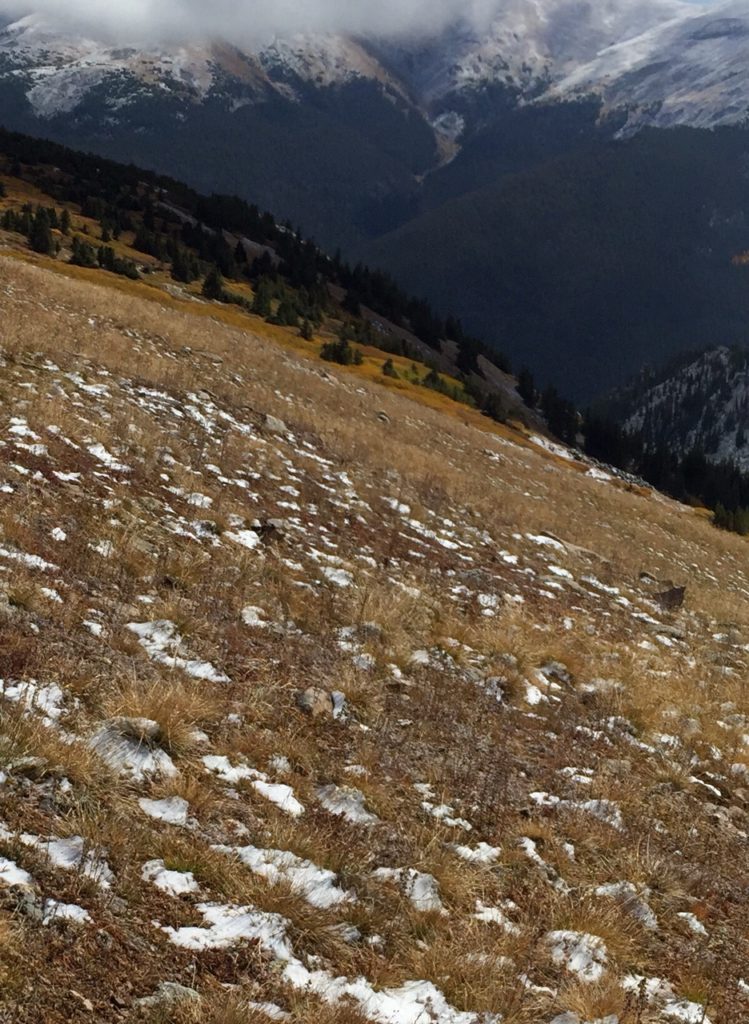
I hike alone, in silence, in lion country, anyway. Because this is my practice. Because this is how I choose to live my life, how I love to live my life. It’s where I would choose to die, given a choice, somewhere wild and stark, like death. Like truth. Like life.
In some ways, maybe I’m trying to emulate the mountain lions.
Above treeline, the trail faded to footprints in places, and I found my way by following the cairns, intentionally stacked rock piles in loose pyramids. They look like they mark graves, and when I see them in the tundra I am always reminded of the windswept charnal grounds high in the Himalayas, where the bodies of the dead are consumed by vultures and the elements. You add a stone as you follow the cairns, to say you passed this way once, and I touched mine to my lips before leaving it behind.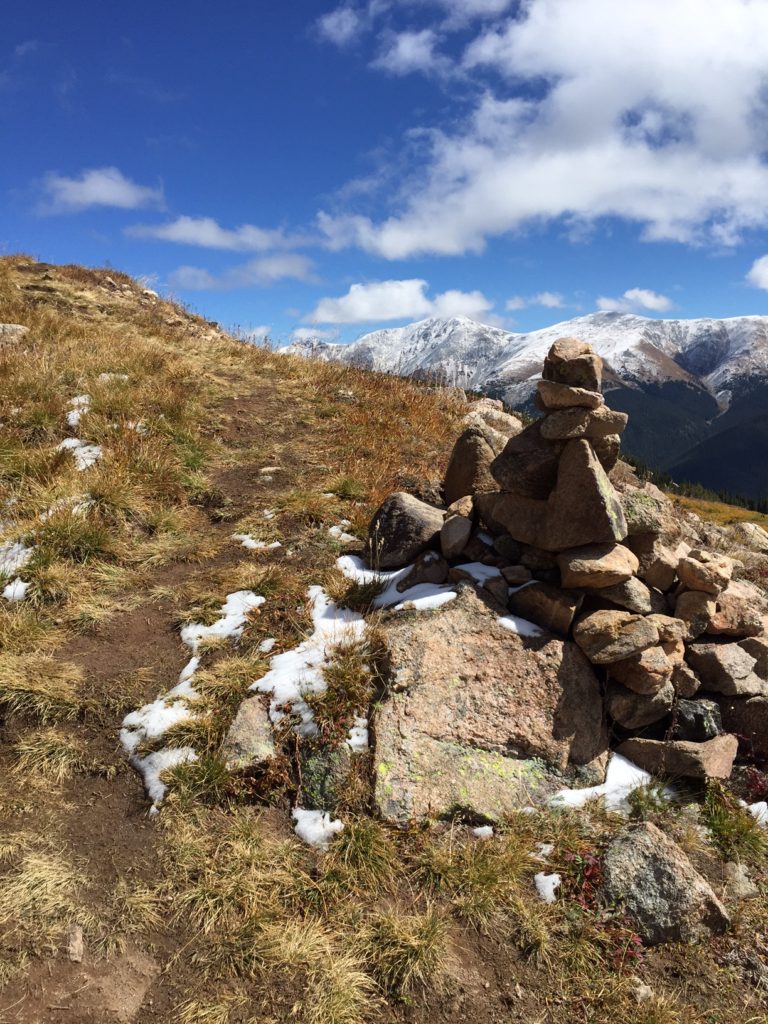
At midday, I sat above a valley so vast I could not even begin to gauge the distance. The mountains had overwhelmed my thoughts. I ate my sandwich, drank my water, and felt insignificant and free and rich beyond measure.
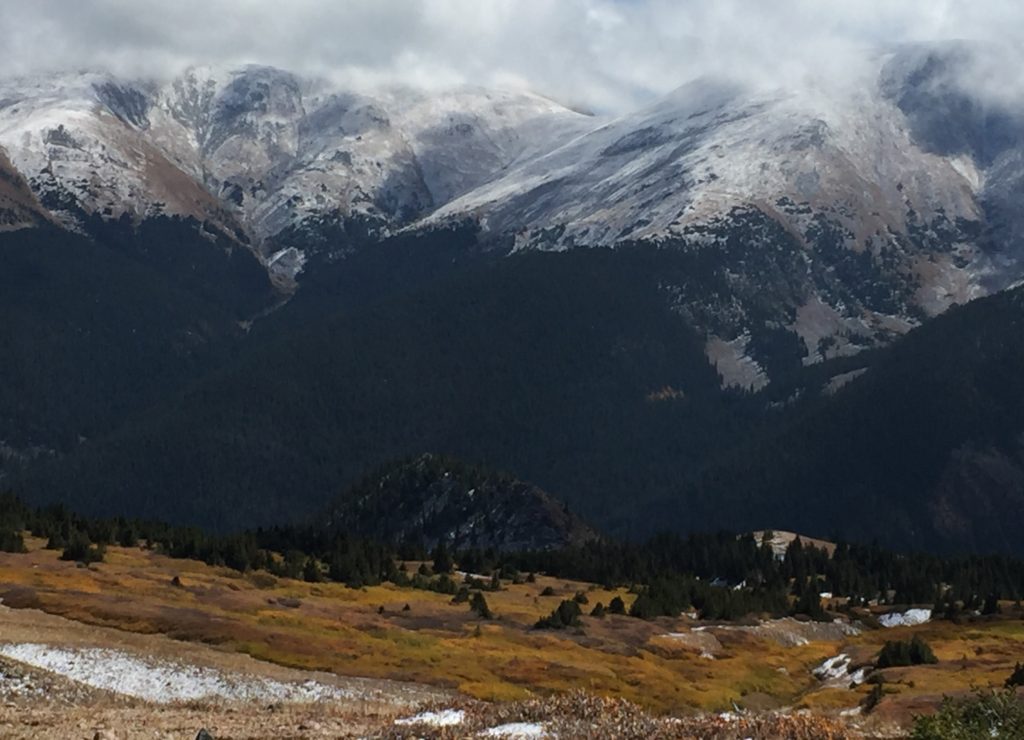
I started to head back the way I came, crossing the tundra by sighting the cairns. Two figures walked toward me. As they got closer, they asked if I would take their picture: they were old friends who first hiked in the most rugged of the Colorado Rockies 40 years ago, now white-haired men with an easy pace and easy smiles. As I took the camera from him, one said, “We were just children, hiking there – what were we doing?” The other replied, “It is because we were children, I think…” and we all laughed. They thanked me for taking the photos and asked if I know if the trail goes all the way over the pass behind us. I told them it peters out, but we all agreed they would find their way, because we could see clearly where they were headed.
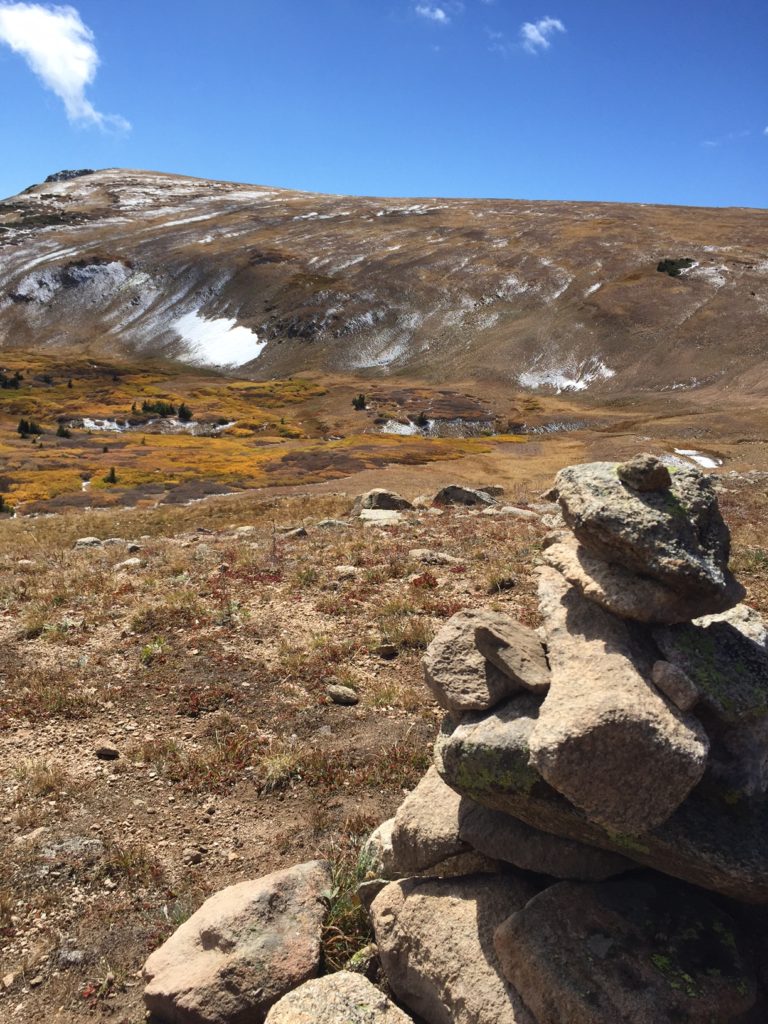
As I hiked down the trail, I noticed again how comfortably the walking stick fit into my hand. I found it eased the steepest inclines, both up and down the trail, just as it eased my first thoughts of a lion encounter. It took the edge off the impact, made the trail feel easier. I began to feel an odd affection for my walking stick, like meeting a new friend as old as myself, out there on the mountain.
With mind distracted, never thinking, ‘Death is coming,’ to slave away on the pointless business of mundane life, and then to come out empty — it is a tragic error. ― Robert A.F. Thurman, The Tibetan Book Of The Dead
It is our misguided beliefs about our omnipotence, about having absolute power over the path of our lives, that make us crazy. We live with our minds constantly distracted. We start to believe that if we live by the rules, get the right degree, marry the right person, buy the right house, eat the right foods – all this rightness will turn to righteousness, and we will prove we can Be Somebody, Make Something of Ourselves. As if we must prove the worth of a life; as if we can. These ideas of rightness and control cloud our minds until we forget we are just human beings, precious children whose hair is slowly turning white over the years, trying to find the path, sighting our line between the voices of those who are here with us now and the stones of our ancestors we follow as far as we can.
We don’t plan ever to be gone – which is, in fact, insane, once you realize what you’ve been ignoring. Time is of the essence, to be living, aware and present, not proving something – that is the great emptiness.
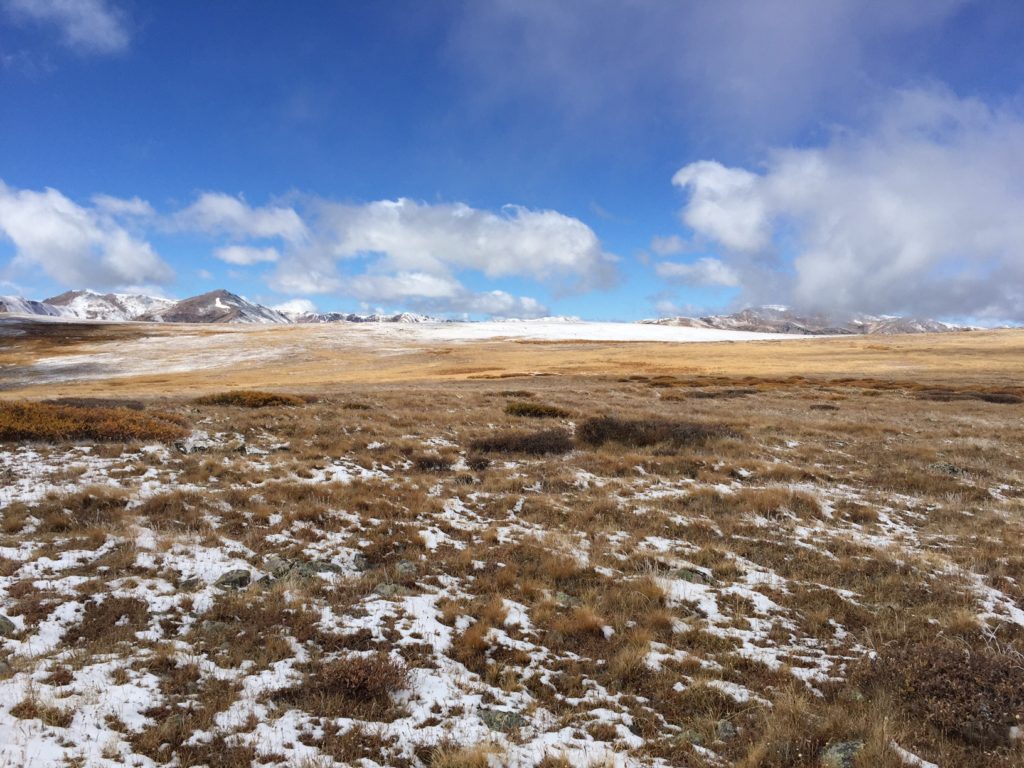
Toward the bottom of the trail, a young family was starting the journey. “Will you take our picture?” Mother and father corralled the two young boys, and all smiled sweetly up the hill at me as I aimed the camera. The little one grinned and lisped through missing teeth, “I wath making goofy thmiles two timesth, but I did a good thmile in one.” Yes you did, I grinned back.
May your smile be easy, like your friendships, and just as goofy, just as abiding. Live your life, fearlessly, because in this way we encourage each other and leave strength for another to find, to help them along their way. If your path be rugged, may it lead to wonder, and when you reach the windswept heights where there is nothing but yourself, may you find a vastness you cannot begin to gauge.

No sane person fears nothingness. ― Robert A.F. Thurman, The Tibetan Book Of The Dead
September 17, 2016 / wanderinglightning / 0 Comments
“Mid-century” is all the rage in 2016: shift dresses that come to the knee, oxfords versus brogues for young men in skinny dress pants, a variety of bar carts on sale for serving mixed drinks like Manhattans and gin and tonics, and boxy 1950’s and 60’s ranch houses filled with sleek furniture with awkward-cool blond wood legs and shabby-chic Renaissance art prints of Blue Boy and Pinkie, a Mondrian-print reusable shopping bag at the door.
I am mid-century. I was born right in the middle of the 60s – not a hippy, but a baby. I grew up in the 70s and 80s amidst all those cliched symbols in everyone’s parents’ homes. Does anyone even understand what they are mimicking here? Sexism. Classism. Judgment. Oppression. Why on earth would you want to glamorize that time and bring it back in any way?
Because of that shopping bag. Re-purposed retro cool.
The thing that attracts today’s mid-century madness is the notion of co-opting images from an earlier time and declaring them Now. New. Neo. Personally, I see heaping melamine plates of irony being served from the bar cart to TV trays all around the new shag carpet.
Just months before I was born at the beginning of 1966, Piet Mondrian’s color block imagery from the 1920s was paid homage by Yves Saint Laurent’s instant classic, the Mondrian Collection, led by the color block cocktail dress. Mondrian himself was not alive to see this, which is a shame given his thoughts about the nature of his art:
“The position of the artist is humble. He 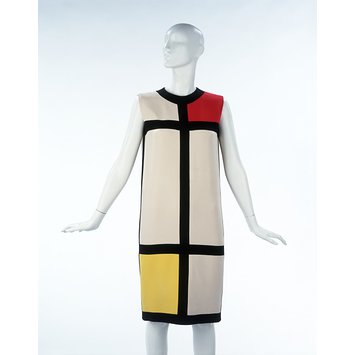 is essentially a channel.”
is essentially a channel.”
Or possibly a Chanel, in this case.
But my reason for bringing his color blocks into this fray is his statement about what abstraction does:
“I wish to approach truth as closely as is possible, and therefore I abstract everything until I arrive at the fundamental quality of objects.”
His Dutch art movement was called De Stijl, which means “the style.” Indeed. Careful what you wish for, Piet. Yves brought his own “style” now – merging the black outlines and colors with the boxy bag-like form of the sack dress. As the buddhists say, form is emptiness, emptiness is form.
The fundamental qualities Mondrian found? In a word: duality. He found opposition and tension.
According to The Art Story: Modern Art Insight,
“Mondrian chose to distill his representations of the world to their basic vertical and horizontal elements, which represented the two essential opposing forces: the positive and the negative, the dynamic and the static, the masculine and the feminine. The dynamic balance of his compositions reflect what he saw as the universal balance of these forces.”
But there’s more. Mondrian himself is quoted as saying,
“The emotion of beauty is always obscured by the appearance of the object. Therefore, the object must be eliminated from the picture.”
And here is where I spill my Manhattan all over your white shag (purely by accident, of course) – here is a tension and opposition that becomes intolerable: as I was being born, women all over the world, first in New York, then Paris and London, then everywhere like a global plague – women were being draped in Mondrian. And just like that, they became mannikins. WE became mannikins. Each woman’s uniqueness being “eliminated from the picture,” the ideal of beauty “no longer obscured” by the messiness of her own personal beauty. Now she was free to float about the all-important 1960s cocktail party as decorative art, rather than as a person. Form. Emptiness.
This feminine ideal is constructed as opposing a masculine ideal, also known as … eh, yeah, sexist stereotypes. Where is Rosie the Riveter from WWII when you need her? OHhh. Rosie was a blue-collar working girl. Yves Saint Laurent did not design for Rosie. Rosie never entered his mind. Rosie could not afford to buy an arty cocktail dress made of silk crepe and lined with crepe-de-Chine, nor could she purchase a sleek davenport, matching Danish-inspired end tables, or that damn drinks cart.
And no one seemed to notice that on both coasts of the U.S., including in New York, for over a decade, artists had already been actively exploring the emotion of not just beauty but a larger reality, by not just abstracting their experiences down to line and color, but abstracted to the full expression of each artist’s essential truth. Abstract Expressionists.
They were women artists.
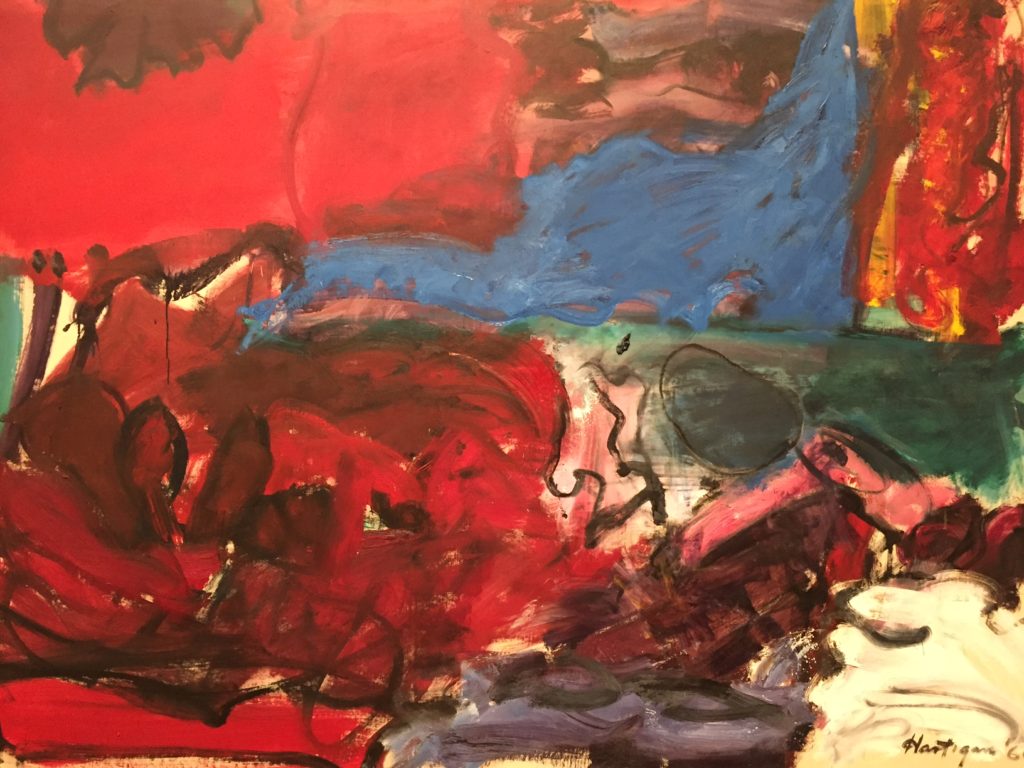
Grace Hartigan: New York City Rhapsody 1960
And they were largely ignored in favor of male artists, some of whom still defined abstract expressionism in relation to their obsession with the female body.
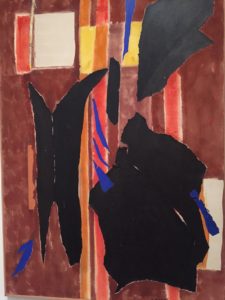
Lee Krasner: Stretched Yellow 1955
The only woman who has gotten significant attention as being a part of the Abstract Expressionist Movement is Lee Krasner, not because her work is the most powerful – it’s not – but I think because she, too, defined her work in relation to the female body; and probably more realistically, because she was Jackson Pollock’s wife. Her husband had affairs, including with Ruth Kligman, a name and face better known than the women artists of the same period, because she had sex with not just Pollock but also with Willem de Kooning. Blah blah blah, cocktail party gossip. Relationship drama does not tell me much about Ruth Kligman and Lee Krasner, the art-dabbling mistress, the long-suffering shadow-artist wife, caricatures of the real women they were.
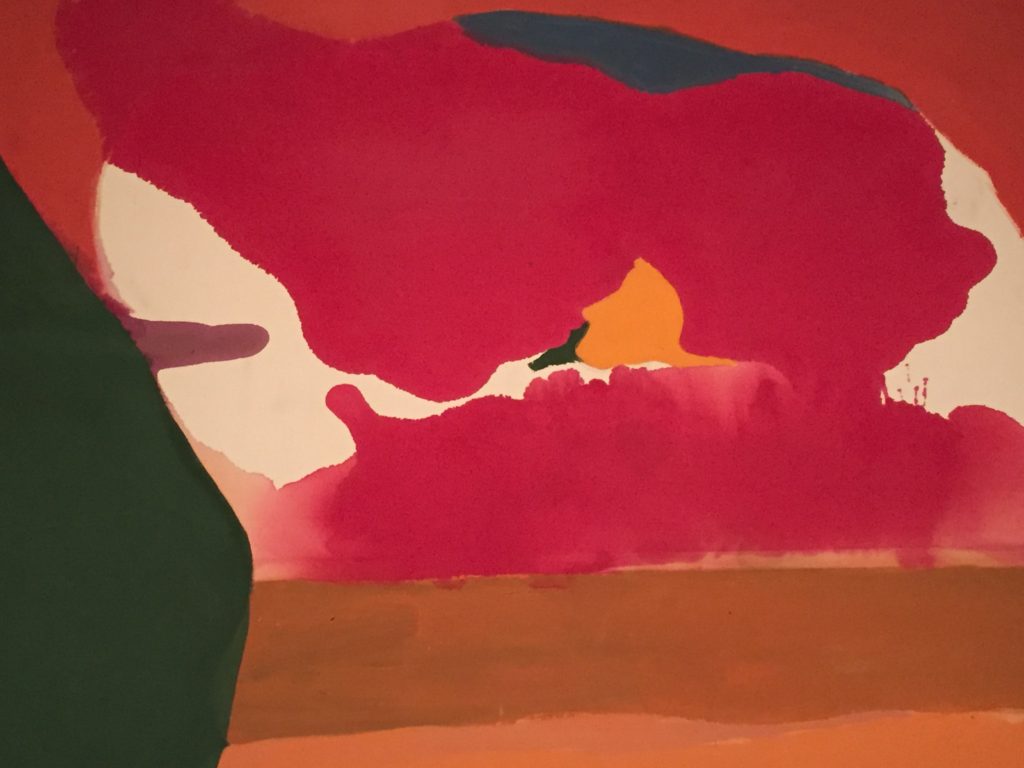
Helen Frankenthaler: Fire 1961
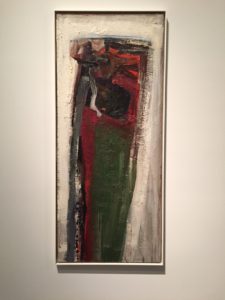
Jay DeFeo: Torso 1952
I found myself extremely frustrated at the Denver Art Museum’s exhibition, “Women of Abstract Expressionism,” which so sincerely offered respect for the artists and their powerful expression.
I moved from room to room, angry that I had never heard of most of these artists. Their work shook me by my shoulders, shouted to me by name, to look – LOOK! Look at us! SEE US! See our experience. See what we are expressing, the fullness of our essential truth.
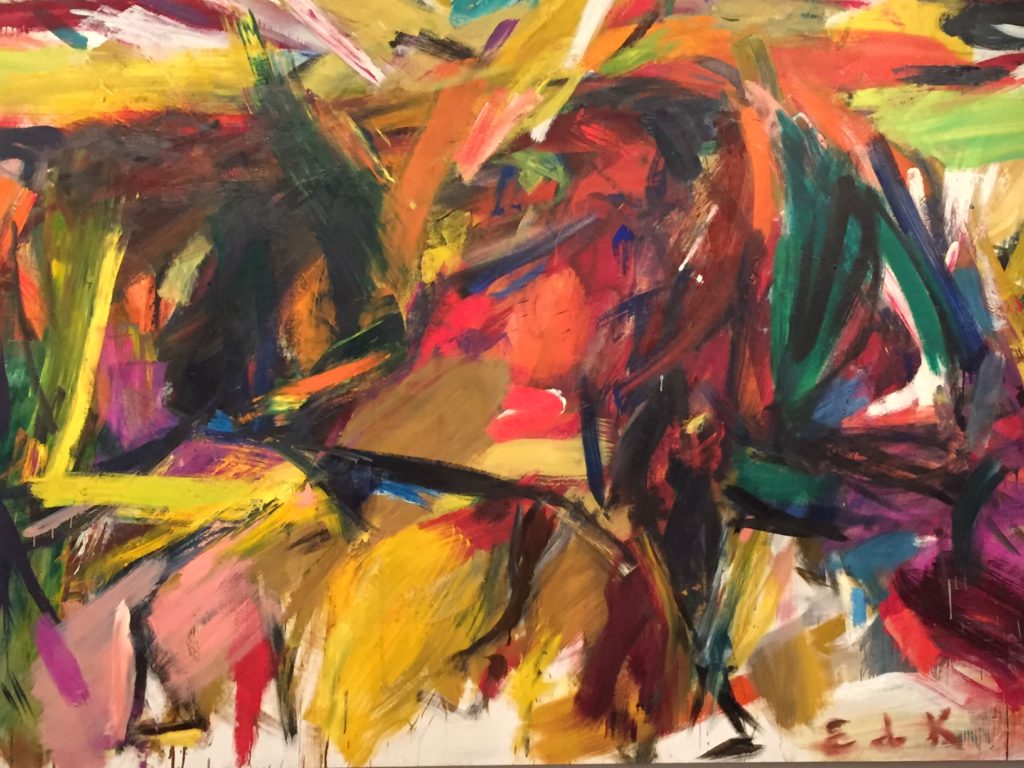
Elaine de Kooning: Bullfight 1959
It would be nice if we had to label an exhibit, “Men of Abstract Expressionism,” so the world would know that men also created art works during this movement. It would be nice if the names Mary Abbott, Jay DeFeo, Perle Fine, Helen Frankenthaler, Sonia Gechtoff, Judith Godwin, Grace Hartigan, Elaine de Kooning, Lee Krasner, Joan Mitchell, Deborah Remington, and Ethel Schwabacher immediately came to mind when we think of art of the mid-century, and we needed to be educated about the names of the male artists.
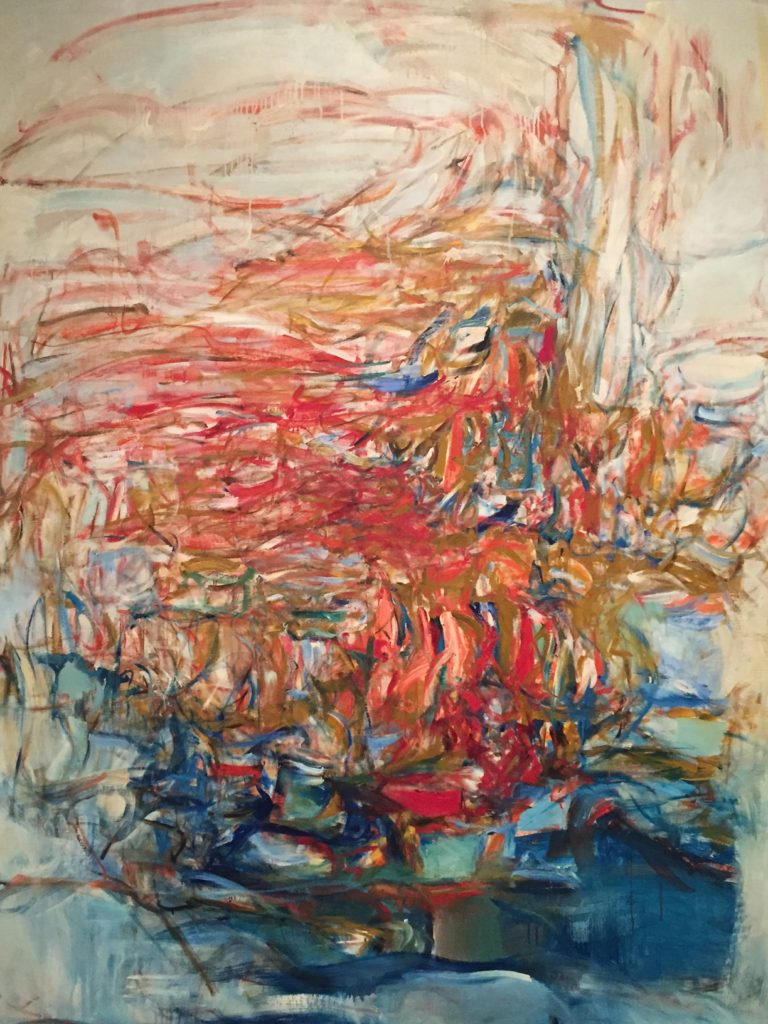
Joan Mitchell: East Ninth Street 1956
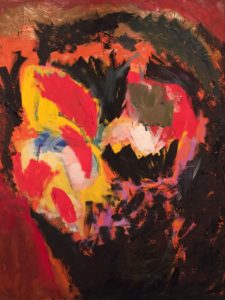
Ethel Schwabacher: Pennington I/Pelham II 1957
It would be even better if we had recognized and embraced their work beyond the coasts when it was first created and exhibited. If it had been been taken seriously. But these were just working girls, like Rosie, rolling up their sleeves and creating what they could in their work spaces until men stepped in and essentially took back their tools, their power, their paychecks, and their opportunities – by receiving all the attention, as the norm. By being the only ones taken seriously.
But those were the times, back then…right?
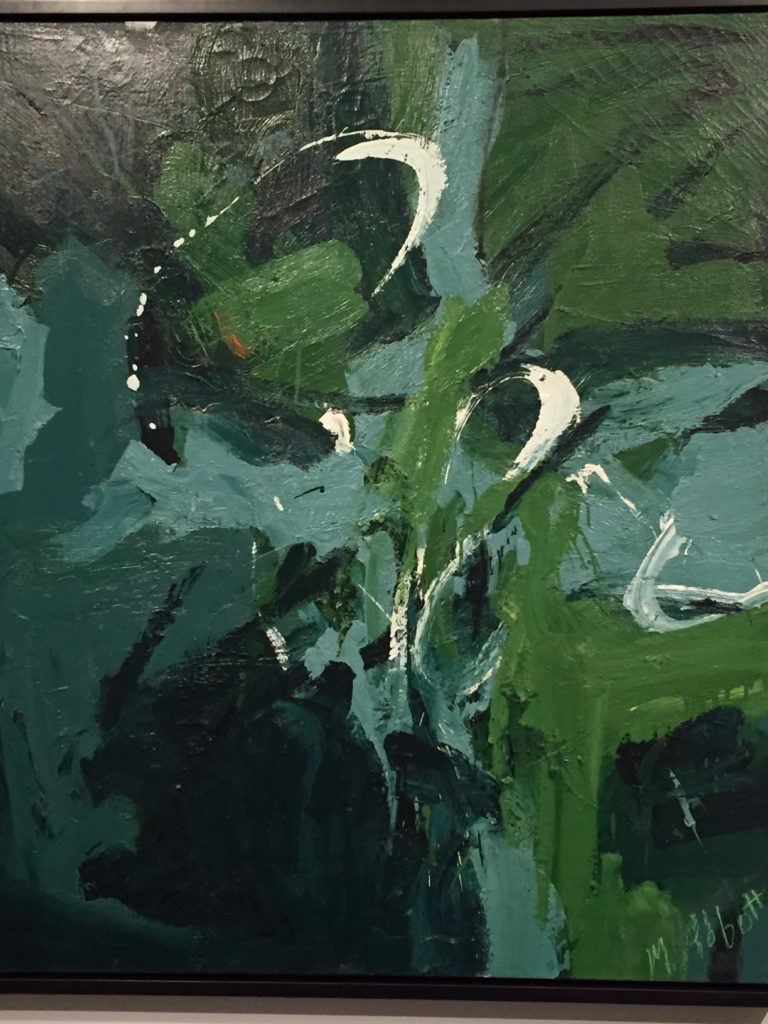
Mary Abbott: All Green 1954
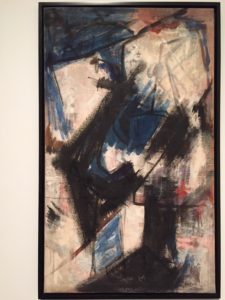
Judith Godwin: Martha Graham–Lamentation 1956
We’ve been held back these 50 years, just in the Abstract Expressionist movement. You listen to the news, look around the world, and cock your head in incredulity at the fact that we still have to honor young women as courageous who simply stand up for their basic right to an education, their right to even be alive, whose faces are burned with acid for perceived acts of dishonor, whose bodies are mutilated for the sexual satisfaction of men, who are judged for their poverty and survival choices by the very people whose money takes advantage of their lack of options.
This is progress?
Perhaps you will forgive me for not being particularly impressed with the current mid-century obsession. So much image, so much money, so little individuality, like Pinkie and Blue Boy making sure we keep our roles straight as straight can be, she in that chaste yet ultra-feminine pink dress, he in that ridiculous man-boy blue suit. Terrible art work. Trite. Cliched. Silly costumed forms really, so out of date, from an earlier time that’s hard to relate to now.
“I don’t want pictures, I want to find things out.” – Mondrian
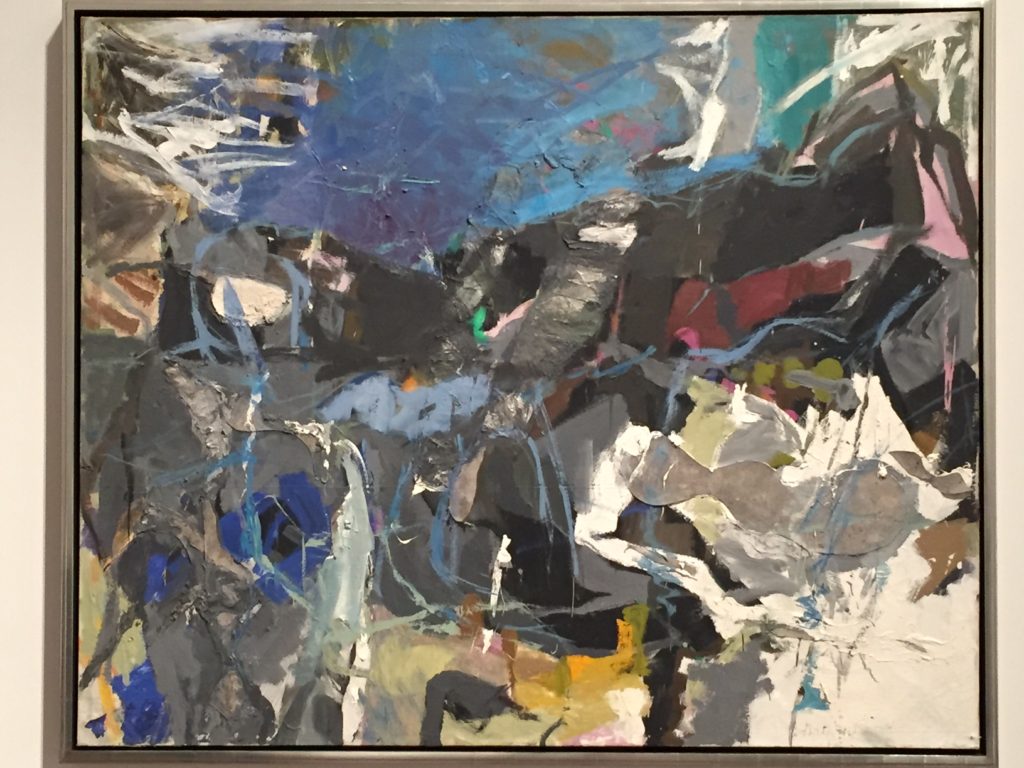
Perle Fine: Summer I 1958-59
Maybe if Perle Fine had worn a Mondrian cocktail dress, we’d have heard of her. But she was “essentially humble,” and just a few years ahead of YSL’s time.
Club soda should take those stains out. Maybe.
I brought you some, in this empty, empty reusable shopping bag.
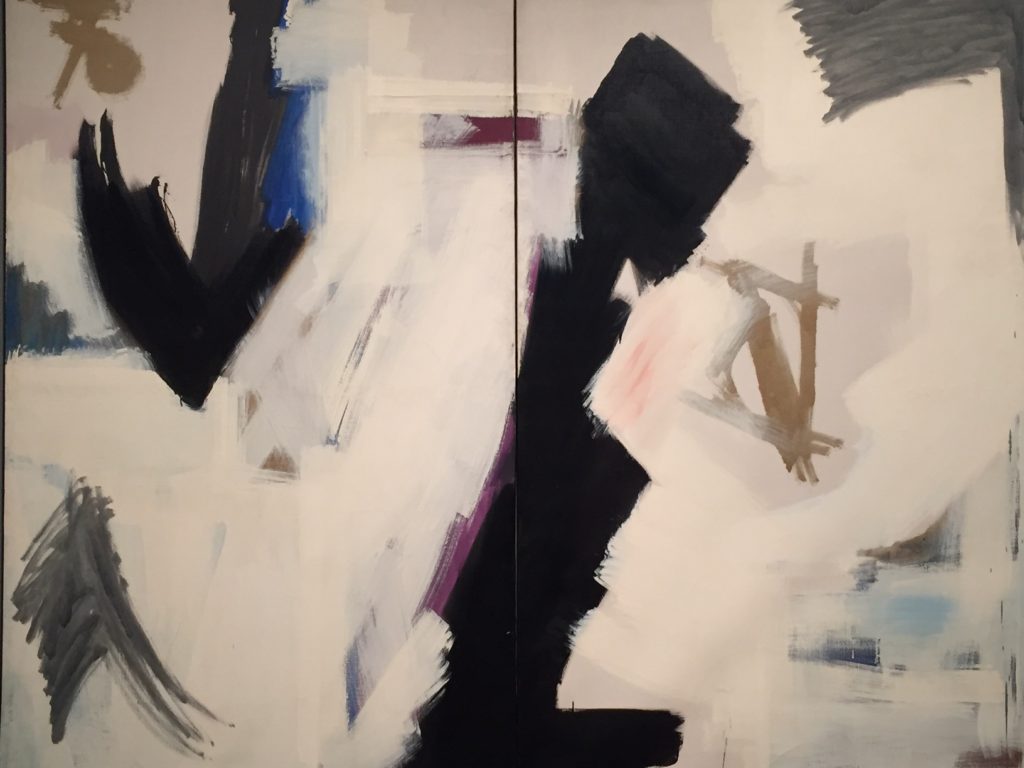
Judith Godwin: Epic 1959 diptych
September 10, 2016 / wanderinglightning / 0 Comments
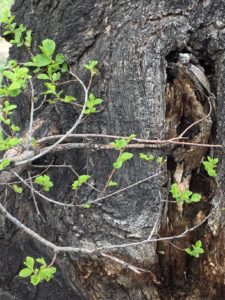 The Earth Day Garden Party had gone well, the day before they cut down the old maple tree on the corner.
The Earth Day Garden Party had gone well, the day before they cut down the old maple tree on the corner.
That’s what I kept thinking as I watched the guys from the tree removal service bring down the severed maple limbs. Spanish flew from ground to treetop and back again, as crows a block away cawed their unheeded alarm. Chains saws buzzed like angry hornets; men worked like ants, picking up enormous chunks of branch onto their shoulders, staggering under the weight of spring wet wood, then dumping it unceremoniously into their metal trailer. Earth Day.
All things share the same breath – the beast, the tree, the man… the air shares its spirit with all the life it supports. – Chief Seattle
It was not an ancient tree. It was not a sapling here on Marshall Street during the reign of the Egyptian pharaohs. GreenPeace did not set up treehouses and refuse to come down, nor did they spike the trunk against the saw. In fact, people just went about their usual business, drove past with a quick glance at the noisy project, continued talking on their phones as they walked by. After all, this was a nonevent. This was not the end of the giant sequoia named General Sherman; the maple was unnamed. It was not ancient – it was just old.
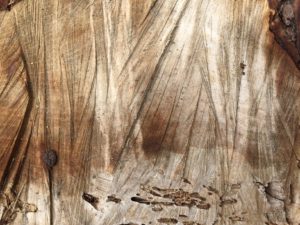 I thought about the old people who had lived in my building previously, for decades under the westerly shade of that huge maple, cool protection from Denver’s unrelenting sun on summer afternoons. The tree’s shadow draped across both the building on the corner and ours next door, leaves fluttering, birds calling. The trees were one of the reasons I chose this apartment.
I thought about the old people who had lived in my building previously, for decades under the westerly shade of that huge maple, cool protection from Denver’s unrelenting sun on summer afternoons. The tree’s shadow draped across both the building on the corner and ours next door, leaves fluttering, birds calling. The trees were one of the reasons I chose this apartment.
A tree’s a tree. How many more do you need to look at? – Ronald Reagan
But the maple was also sickly and imperfect, as we get when we become older. It still provided shade, but had some dead limbs, leafless patches here and there. As I listened to the chainsaws, I thought of Betty, her intelligent eyes, self-possessed beauty of her wrinkled and freckled skin, thick silver hair pulled up, telling me in the hallway how she had lived here for 23 years before the new owners raised all the rents hundreds of dollars and priced her out of her home. She held a box of personal mementos in her hands as we spoke. She carried it out to the backseat of her car, and then, she just drove away. That was it. I never saw her again.
…there are always tremors when a great tree falls. – Rajiv Gandhi
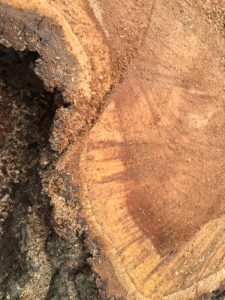 Old age, fixed income. That’s what made them all vulnerable. That’s why David in the apartment below mine loaded up his old Subaru with his fishing poles and tackle box, pots and pans and clothes, heading to stay in the basement of a friend in another city. That’s why Rick, the mile-a-minute endless storyteller, is moving his recliners and multiple TVs into veteran housing. That’s why Our Lady of The Back Stairs no longer slowly pushes her trash bag with her foot along the downstairs hallway and out to the dumpster. She has just disappeared, gone in a day, like the tree.
Old age, fixed income. That’s what made them all vulnerable. That’s why David in the apartment below mine loaded up his old Subaru with his fishing poles and tackle box, pots and pans and clothes, heading to stay in the basement of a friend in another city. That’s why Rick, the mile-a-minute endless storyteller, is moving his recliners and multiple TVs into veteran housing. That’s why Our Lady of The Back Stairs no longer slowly pushes her trash bag with her foot along the downstairs hallway and out to the dumpster. She has just disappeared, gone in a day, like the tree.
Ye are the fruits of one tree and the leaves of one branch. – Baha’u’llah
 It’s such a loss. I feel robbed, that angry, hurt, helpless feeling of outrage and futility. The other reason I really liked this apartment was the mix of people – different cultures, ages, perspectives. It was surreal to watch from my third floor bedroom window as now Kathy set out her yard sale, the next white-haired neighbor to display on the lawn her boxes of books, lamps, dishes, linens, trinkets, all the things she did not have room for as she moved into the senior housing she’d been lucky enough to find. With my cup of coffee, I walked to the balcony doors, where I watched and listened as the maple tree groaned and split, it’s twigs and leaves strewn across the grass and sidewalk, just like Kathy’s yard sale. All the little bits of their lives that nobody really needed.
It’s such a loss. I feel robbed, that angry, hurt, helpless feeling of outrage and futility. The other reason I really liked this apartment was the mix of people – different cultures, ages, perspectives. It was surreal to watch from my third floor bedroom window as now Kathy set out her yard sale, the next white-haired neighbor to display on the lawn her boxes of books, lamps, dishes, linens, trinkets, all the things she did not have room for as she moved into the senior housing she’d been lucky enough to find. With my cup of coffee, I walked to the balcony doors, where I watched and listened as the maple tree groaned and split, it’s twigs and leaves strewn across the grass and sidewalk, just like Kathy’s yard sale. All the little bits of their lives that nobody really needed.
God has cared for these trees, saved them from drought, disease, avalanches, and a thousand tempests and floods. But he cannot save them from fools. – John Muir
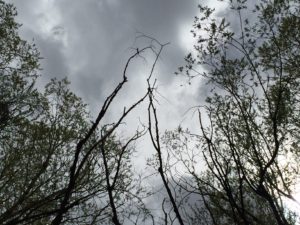
The noncommital shoppers meandered through the yard sale, the tree men sawed branches to length and tossed them over the side of the trailer. I sipped my coffee, room to room, window to window, slowly back and forth, watching both lives come down as crows picked at the remains of a squirrel in the street, and the afternoon turned overcast and threatened rain.
Every crag and gnarled tree and lonely valley has its own strange and graceful legend attached to it. – Douglas Hyde
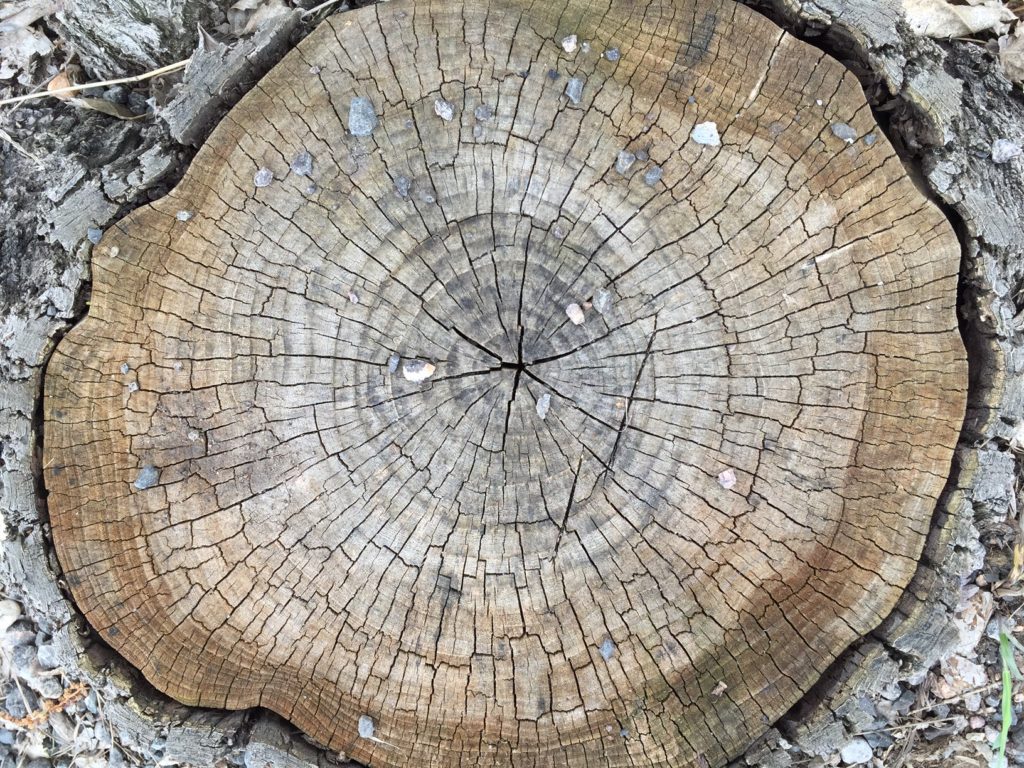
April 15, 2016 / wanderinglightning / 0 Comments

Patience is not passive; … it is active; it is concentrated strength.
Every day, I would read those words on a poster in the coat room, as I walked through the United Way daycare to pick up my children. The poster’s image was nothing, meaningless, now forgotten – the words, arresting. Every single day.
I had minimal patience in those days. In my mid-20’s with a failed marriage, no education, and three preschoolers to shepherd out to the bus stop and home, my days consisted of proving my worth at work, my nights of making supper, giving baths, reading stories, and singing lullabies until I myself fell asleep, my arms outstretched to hold tiny hands reaching out from a baby crib on one side, bunk bed on the other side, holding our world together by sheer will within that apartment bedroom.
But each day, Monday through Friday, that poster at the daycare caused me to physically hesitate, my thinking skip a beat, the quick in-breath, mental note. Patience. Strength. It took me 25 years to look up the author: Edward G. Bulwer-Lytton, a British poet, novelist, and politician who lived in the 1800’s. He is the author of that classic, ridiculously dramatic opening line: “It was a dark and stormy night….”
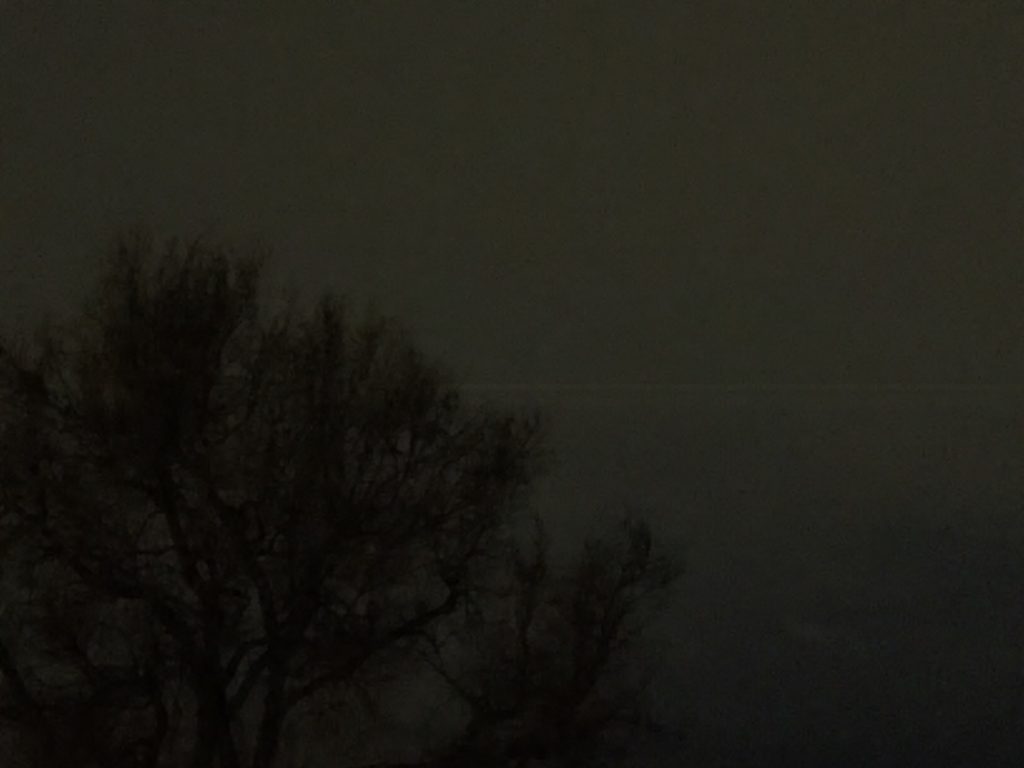
That was the essence of my 20’s, maybe everyone’s 20’s. I had certainly created a dark and stormy night for myself, a time of intensity and difficulty and fearful mess. Yet I was drawn to this hope that patience could be a practice of actively collecting strength for a time when it is needed most. That I could learn to stay calm, wait out the storm. That I could gain certainty the storm would indeed pass.
Samuel Beckett’s Waiting for Godot has been acclaimed by some as the most influential literary work of the 20th century. It has also been famously described as a play in which nothing happens – twice. Beckett had a thing for bicycles, inserting bicycles into most of his works, even going so far as to create a piece in which Act 1 is entitled “8,” the two wheels vertical, and Act 2 is the figure 8 horizontal, the symbol for infinity. But in Waiting for Godot, he did not; instead, the play itself is the bicycle: two acts, two main characters as a dysfunctional societal team talking about taking action who never do, interacting with two antagonist political characters representing power and worth, all things in tandem, in tension. But riderless, as they wait for the unseen, unknown Godot who never arrives, “but surely tomorrow.”
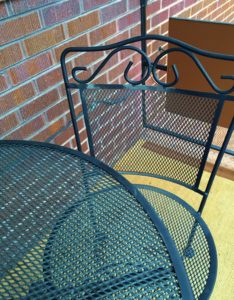
So often, we talk about the worth of our lives, but we fail to act. We wait. And wait longer. It feels like watching a play in which nothing ever happens. It is actually allowing fear to mean more than possibility. It is impatient with the discomfort of life, yet still passive. Riderless.
When we are young, we are shocked by the deceit and violence in the world. So much drama. Our attention is utterly captive to this “dark and stormy night.” We may fall into despair, that occupational hazard of being human, of existing in a corrupt society and cruel world. We can fear for our very lives, our future. We fear for the lives entrusted to us, as well, the ones who cry with small voices when they get tired, complain endlessly over their temporary hardships, expect nurturing and comfort, and demand both meaning and entertainment in their interactions.
Or is that the characters waiting for Godot.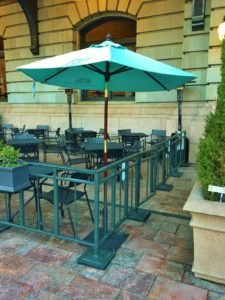
Or is that me. Still. All these years later.
If I staged Waiting For Godot, I would make the first act Youth – so many ideas, possibilities discussed, dreams awaiting. For the second act, I would costume the characters as Adulthood – business people in dull suits, still sitting in the same place, same ideas, same possibilities discussed, dreams still waiting.
On some level, we know. We know that to avoid failing at something meaningful, we stall with endless, meaningless postponement. Mundane drama. Where nothing continues to happen.
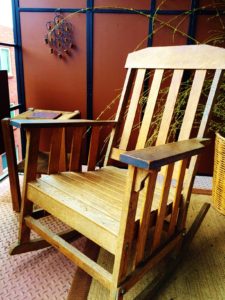
Beckett has said that this play was not about waiting for God, for a God Moment. He told one interviewer that, in fact, he had spent just such a day waiting to catch a glimpse of a well-known bicyclist in a road race, a man named Godeau, who never came by where Beckett waited. So he wrote about what he experienced. Does that make his play less meaningful, less symbolic of the way we live our lives? Beckett had a realization of the futility of waiting passively for something wonderful to show up in his life.
May we all have such a moment.
“Books are but waste paper unless we spend in action the wisdom we get from thought.” – Edward G. Bulwer-Lytton
 I am waiting, here with Edward G. Bulwer-Lytton. I am concentrating my strength as I save and plan, getting ready to go out into the world and “spend in action the wisdom” I am gaining. Maybe Ed started out in that dark and stormy night, young and dramatic, just like me, but he also later wrote The Last Days of Pompeii. And also this:
I am waiting, here with Edward G. Bulwer-Lytton. I am concentrating my strength as I save and plan, getting ready to go out into the world and “spend in action the wisdom” I am gaining. Maybe Ed started out in that dark and stormy night, young and dramatic, just like me, but he also later wrote The Last Days of Pompeii. And also this:
“Patience is the courage of the conqueror, the strength of man against destiny.”
Feel like those words could take me somewhere.
December 19, 2015 / wanderinglightning / 0 Comments
Sometimes you hear a voice through the door
calling you….
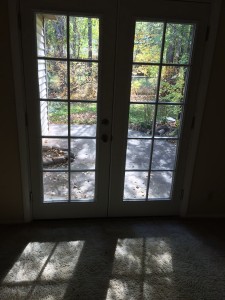 For the past year, I have been listening for that voice beyond the door, the one the poet Rumi listened for in 13th-century Persia. It has called to me several times. Last November, it was the voice of my son-in-law asking if it was time to go to the hospital, as my very pregnant daughter’s intense face answered the question; we all changed forever as we crossed a new threshold with the birth of that sweet baby. We all got to live together for a time, in wonder and chaos, baby and parents and grandmother and uncles, moving in and out of each others’ space and each others’ lives in the rattly old house in Fort Collins.
For the past year, I have been listening for that voice beyond the door, the one the poet Rumi listened for in 13th-century Persia. It has called to me several times. Last November, it was the voice of my son-in-law asking if it was time to go to the hospital, as my very pregnant daughter’s intense face answered the question; we all changed forever as we crossed a new threshold with the birth of that sweet baby. We all got to live together for a time, in wonder and chaos, baby and parents and grandmother and uncles, moving in and out of each others’ space and each others’ lives in the rattly old house in Fort Collins.
In January, it led me out of my job in the homeless center in Fort Collins toward a similar refuge for homeless women in downtown Denver. During the week, I was welcomed to stay within the circle of friends’ arms, within their generosity of spare rooms and morning coffee and daily greetings and partings. On the weekends, I traveled back up to Fort Collins.
Driving around apartment-hunting, I stumbled upon an interesting community in North Denver called “Aria.” Here they were re-envisioning the 17 acres that had belonged to the Sisters of Saint Francis of Penance and Christian Charity – creating a mix of affordably-priced apartments, market-rate townhouses, low-income senior housing – even the convent itself was being fashioned into cooperatively-owned condos in the co-housing model. Community gardens, bike paths, bus lines, and a new lightrail station to be built within the next year all beckoned. Yet when I applied for the apartments, I was disappointed to learn that while my social work income reflected my own “vow of poverty” similar to the Sisters, I was $50/month over the income limit.
By mid-summer, I found a tiny one-bedroom apartment over a coffee shop near Sloan’s Lake instead. Here my 13-year-old son and I brought the essentials of our home and learned the pleasure of letting go of things unneeded. He skateboarded ahead while I ran the path around the lake, we found a new favorite pizzeria, and even caught a Rockies’ baseball game downtown.
I stayed in communication with Aria. They needed someone a few hours each week to provide their residents with community resources, and so even though I wasn’t able to live there, I gained the opportunity to work there. On Friday afternoons I would arrive to meet with a young woman worried about her boyfriend’s abusive tendencies, a family looking for utility assistance, or older people in need of slow conversation and time for story-telling. There always seemed to be just enough time to reassure, to connect, to enjoy.
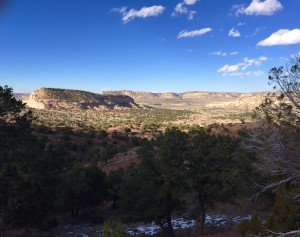 In July, my daughter and her husband moved with the baby to opportunity in New Mexico. Helping them move became a beautiful road trip into that quiet spaciousness. With a teaching job and a sweet little house of windows and wood floors, they began to unpack their boxes and their new life as a family.
In July, my daughter and her husband moved with the baby to opportunity in New Mexico. Helping them move became a beautiful road trip into that quiet spaciousness. With a teaching job and a sweet little house of windows and wood floors, they began to unpack their boxes and their new life as a family.
Each weekend, my oldest son and I were emptying the old house. We had enough to furnish the little house in New Mexico, my apartment in Denver, and his new apartment downtown, and still bring load after load to donate to the thrift stores. When my second son moved back to Denver from the Midwest, he arrived just in time to share in the bounty…and the hauling. The old house was clean and clear. My younger daughter, finishing college in Boston, was able to see it one last time, and reminded me that she had made me promise to get out of that house and into the wider world before she graduated college.
In November, the house sold. I am free. I am keeping my word.
Last Friday, I arrived at Aria to an interesting conversation: a change had come, an unexpected opportunity. Would I like to work there fulltime? I told them I already had a great job during the week that I really enjoyed. Aria said they would match my salary. And – would I like the free apartment that comes with it?

Sometimes you hear a voice through the door
calling you, as fish out of water hear the waves,
or a hunting falcon hears the drum. Come back. Come back.
Rumi was right. Don’t give up. Keep listening for that voice calling to you. It is your own voice, calling you back to yourself in this one precious lifetime. Stay true. Sometimes the call is muffled; but at other times, it sings.
This turning toward what you deeply love
saves you. Read the book of your life,
which has been given you.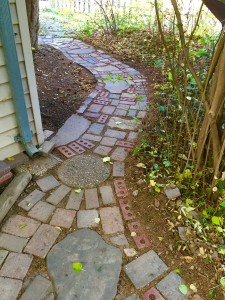
A voice comes to your soul saying,
Lift your foot. Cross over.
— Rumi
 I got a room at the Cameron Trading Post, circa 1916, where you can still walk into the deep Southwest, buy a bag of Bluebird flour, some jerky, coffee, and a blanket woven by an Indian, sold by an Indian. The trading post still holds the south bank of the Little Colorado River, and I watched it wind its muddy way west under the deepening sky to join the canyon I would see tomorrow.
I got a room at the Cameron Trading Post, circa 1916, where you can still walk into the deep Southwest, buy a bag of Bluebird flour, some jerky, coffee, and a blanket woven by an Indian, sold by an Indian. The trading post still holds the south bank of the Little Colorado River, and I watched it wind its muddy way west under the deepening sky to join the canyon I would see tomorrow.red mud trail




































 is essentially a channel.”
is essentially a channel.”

























